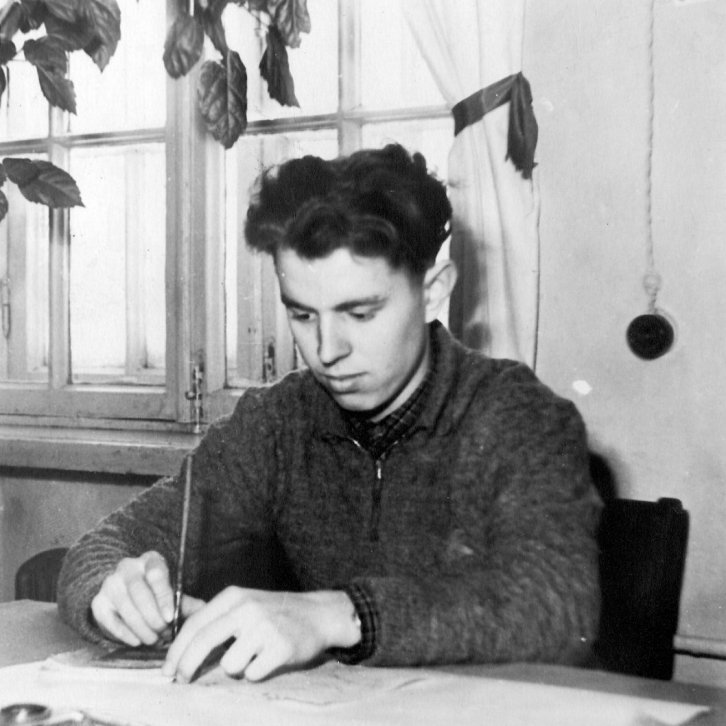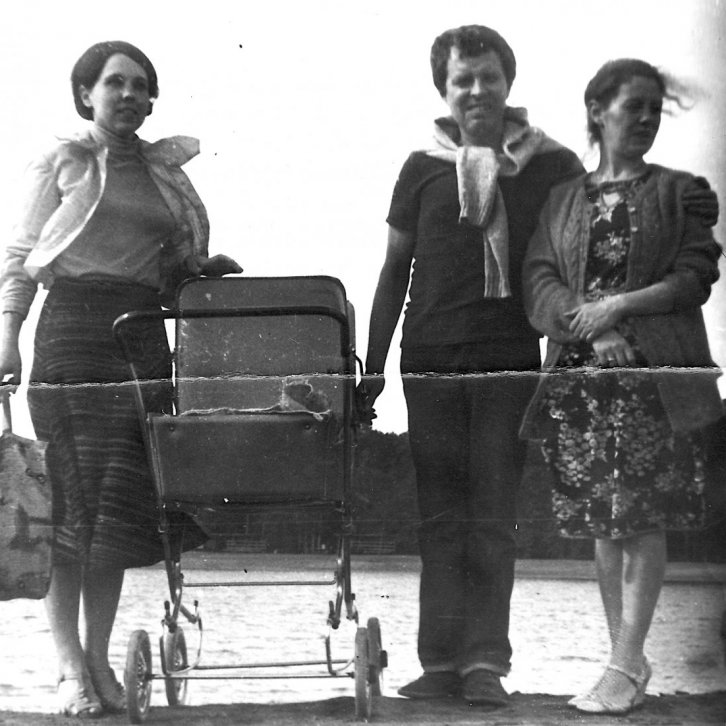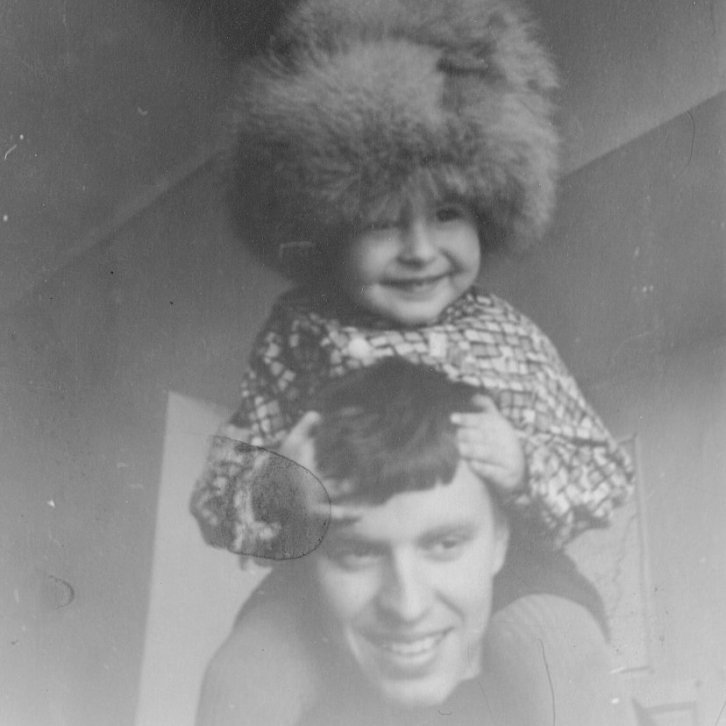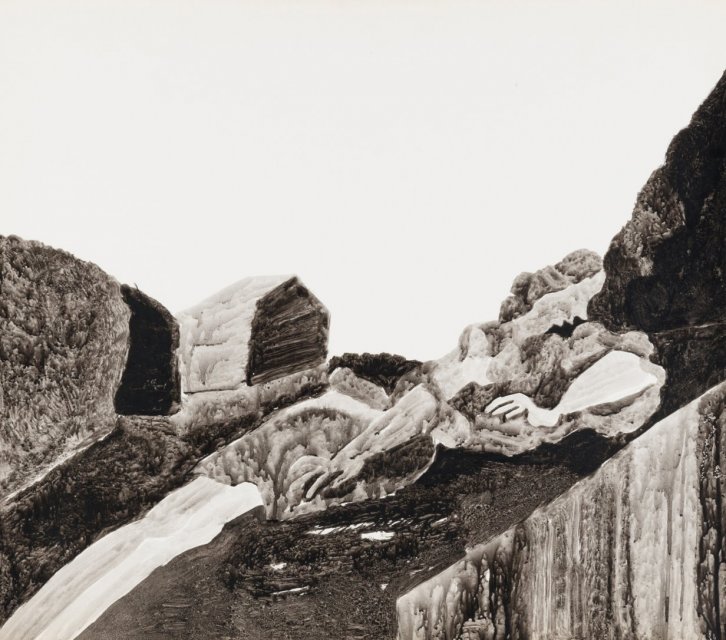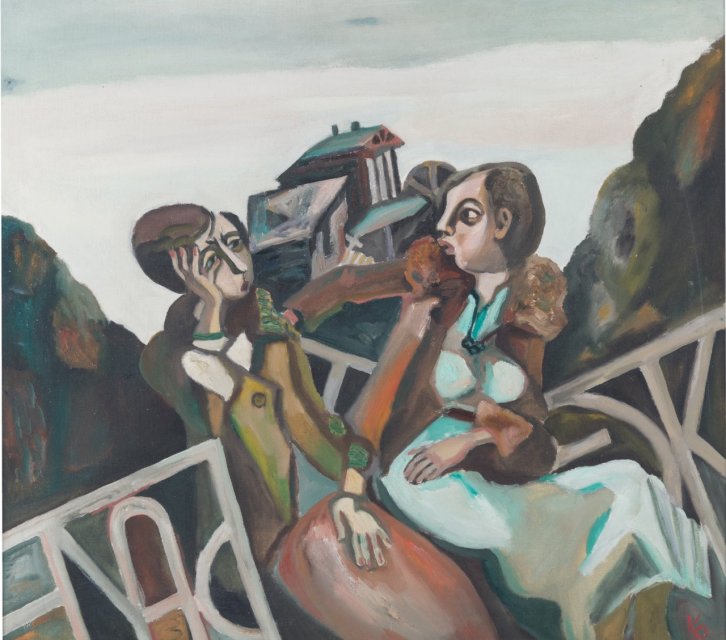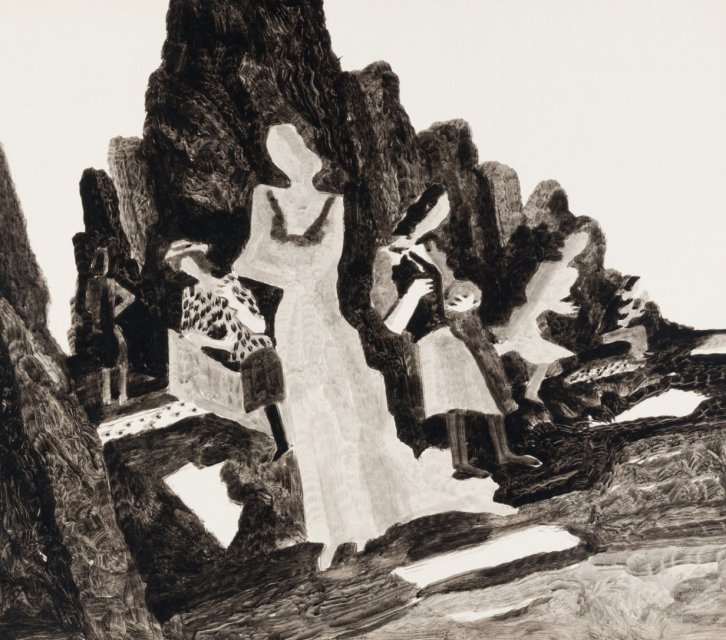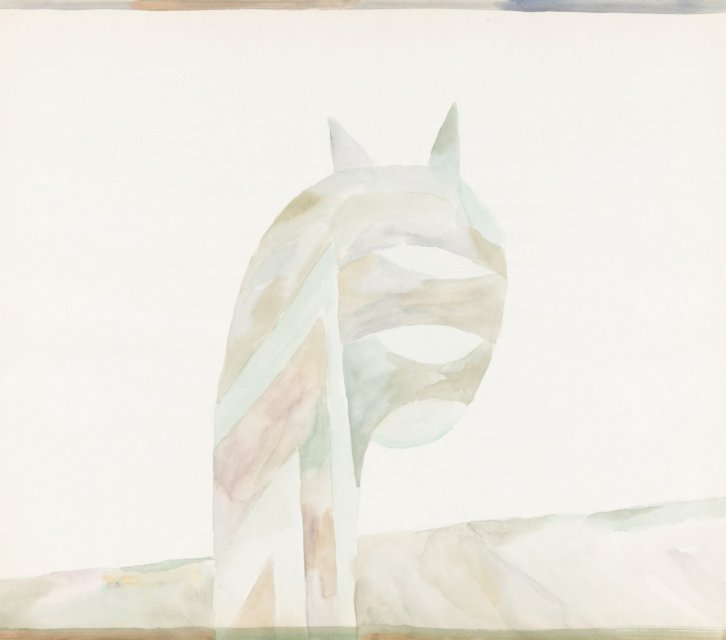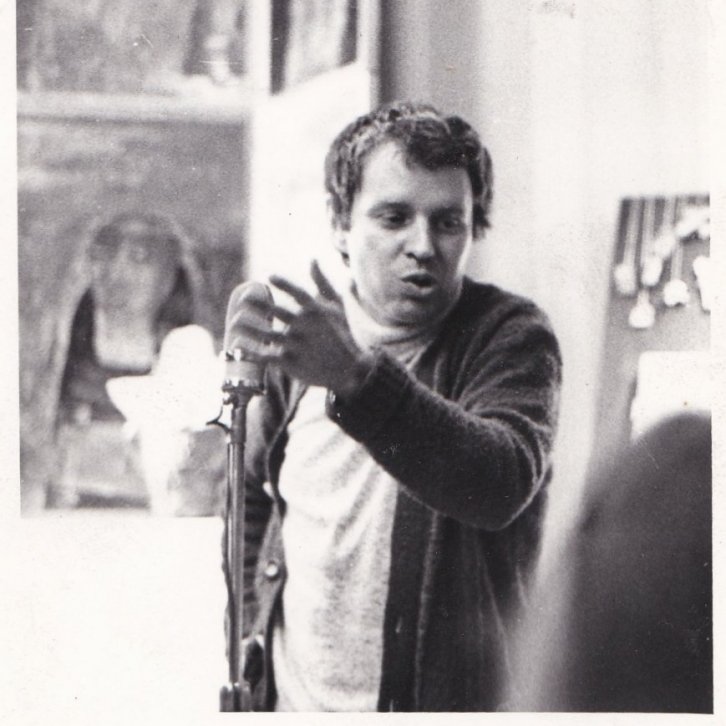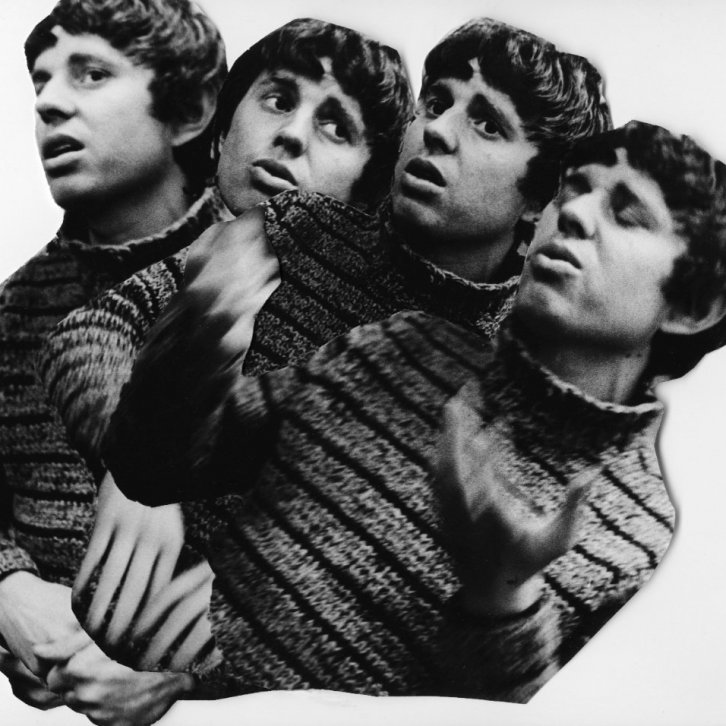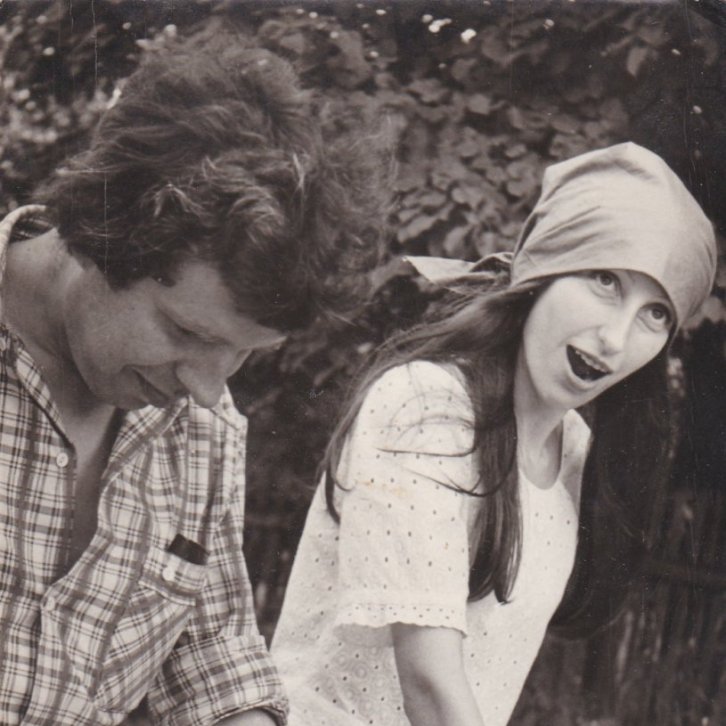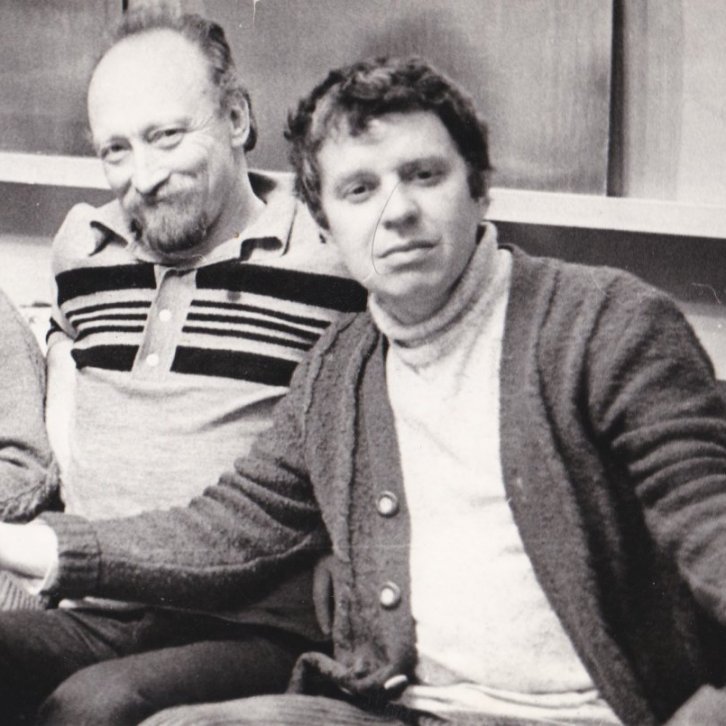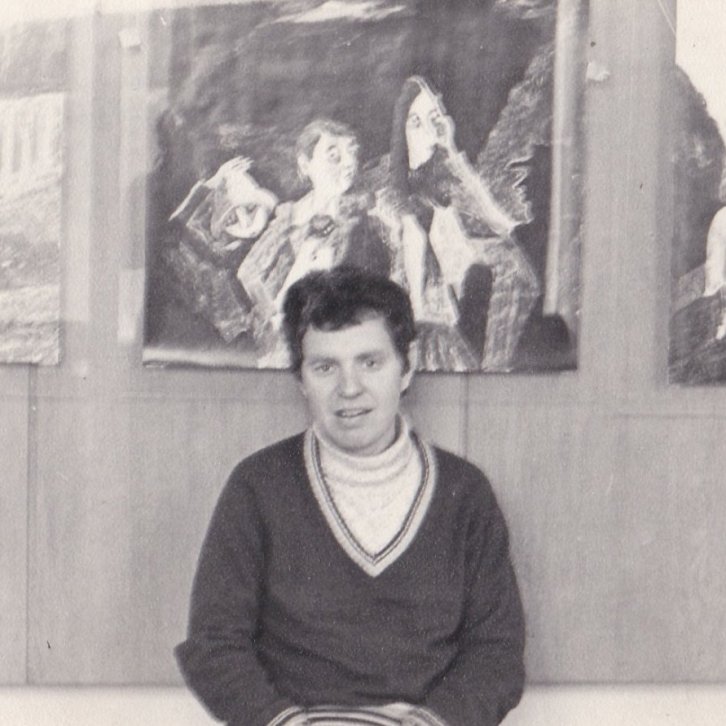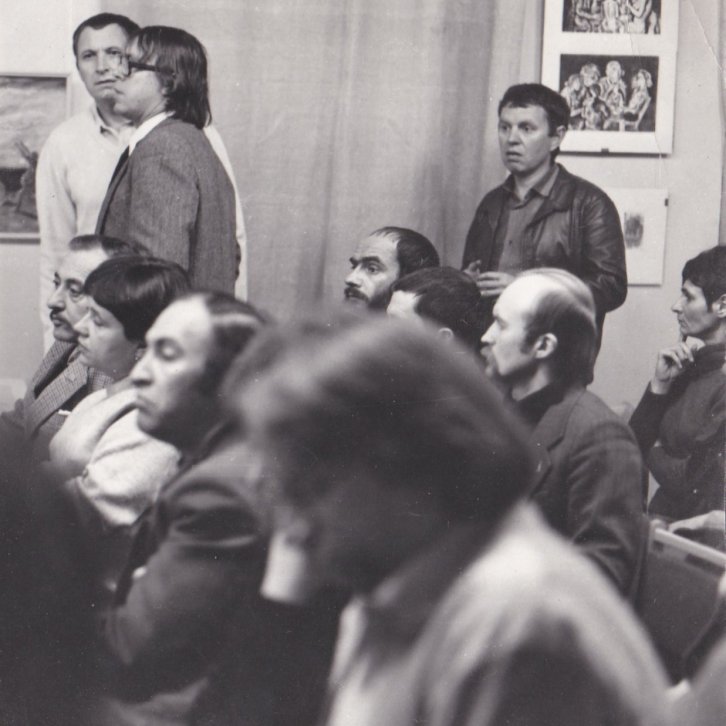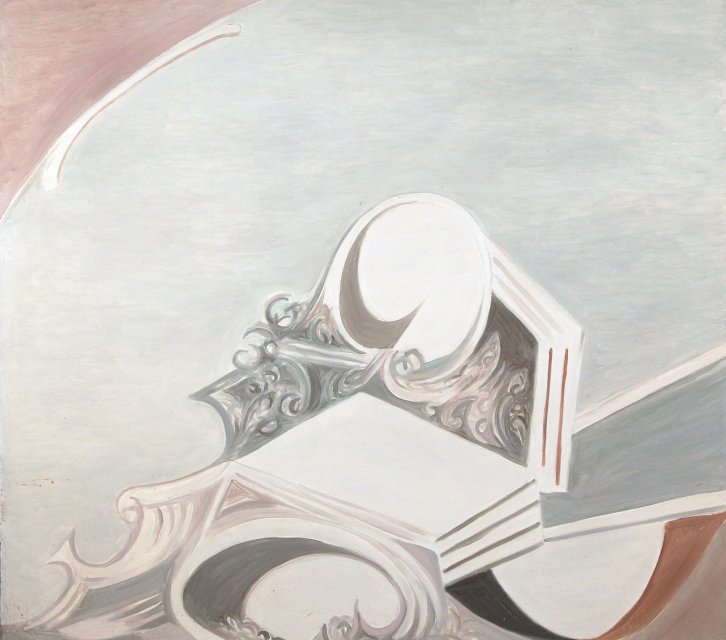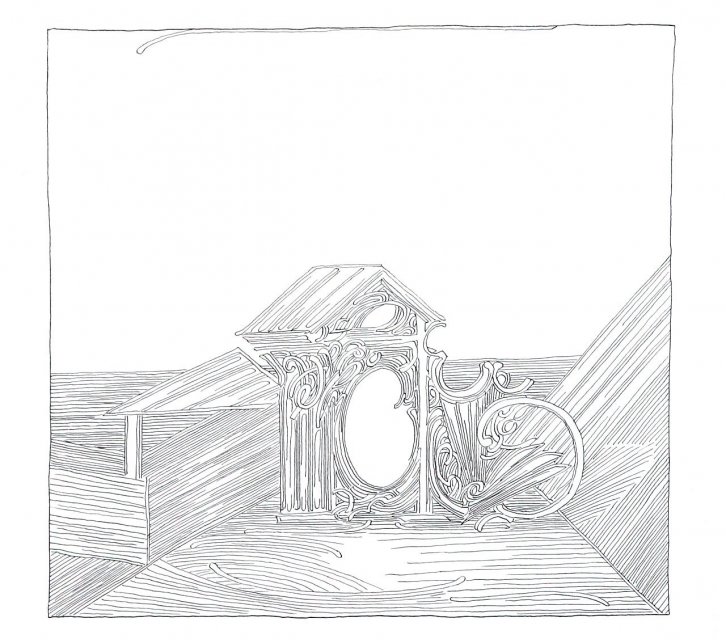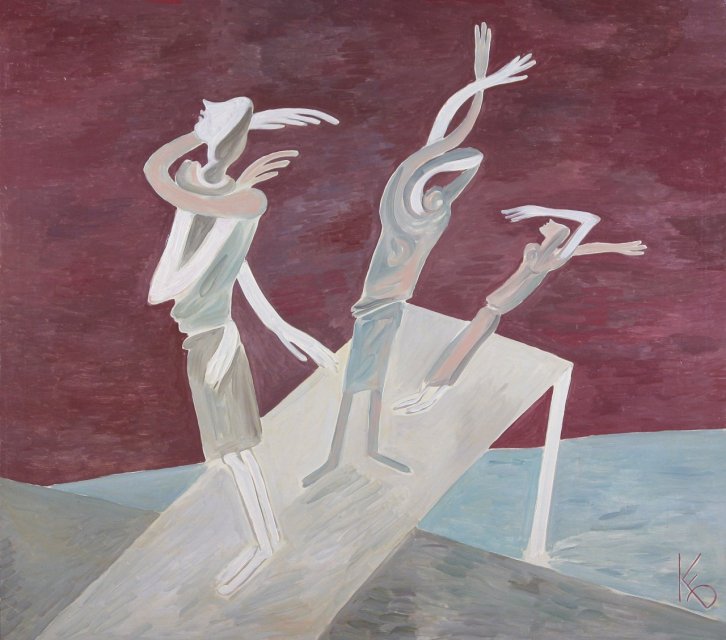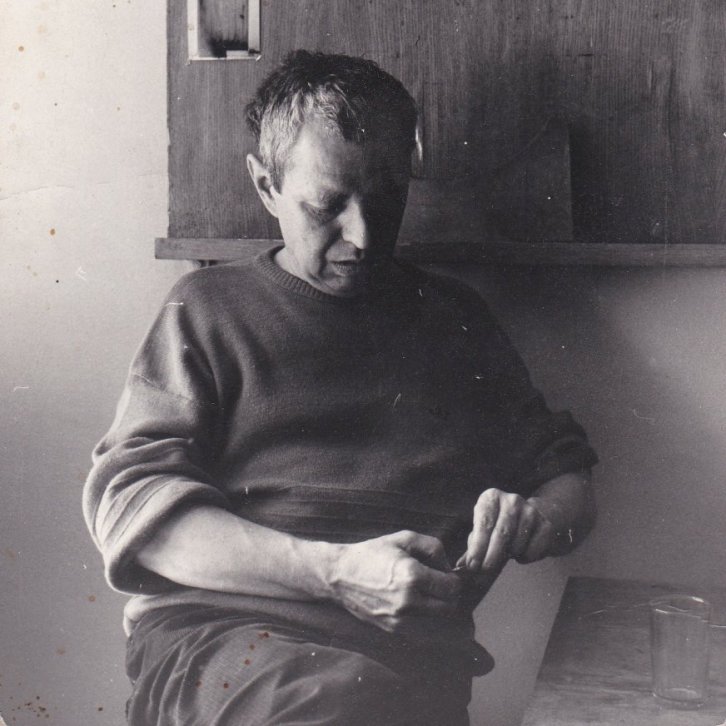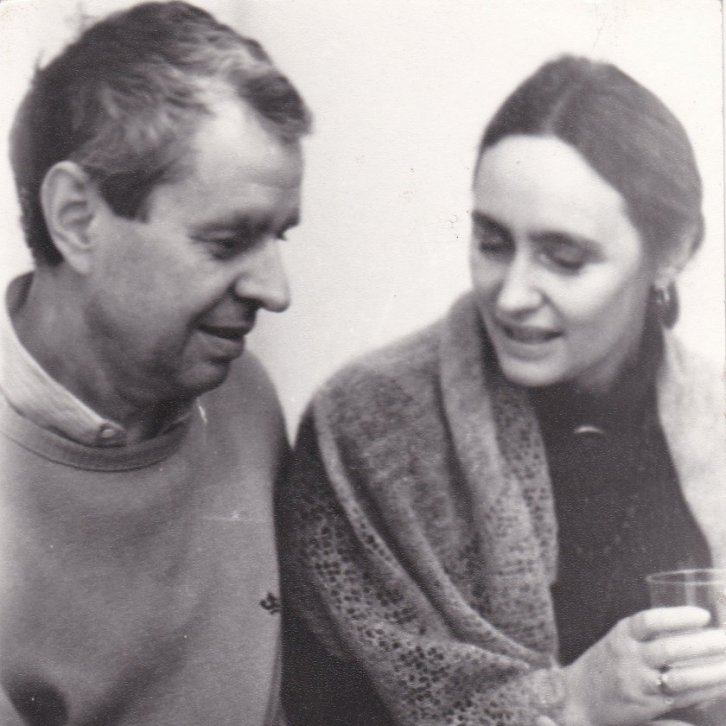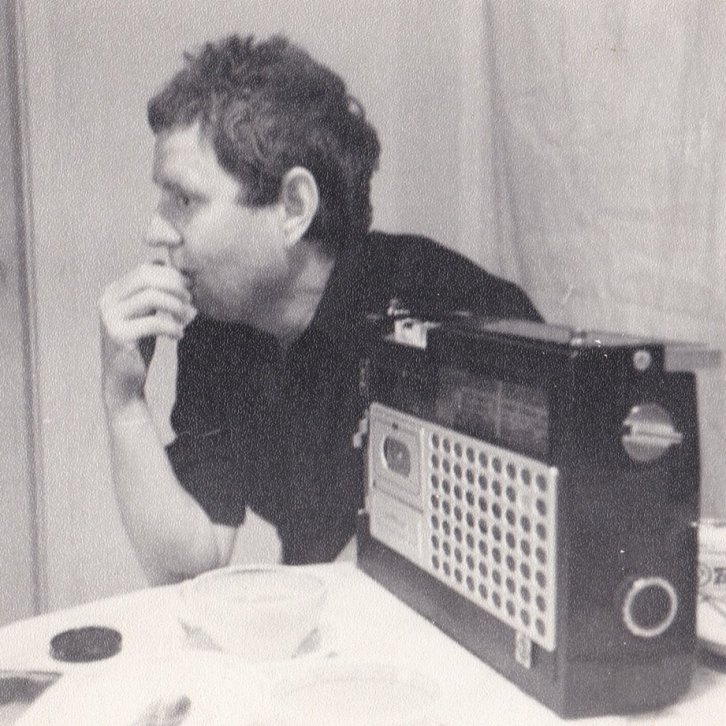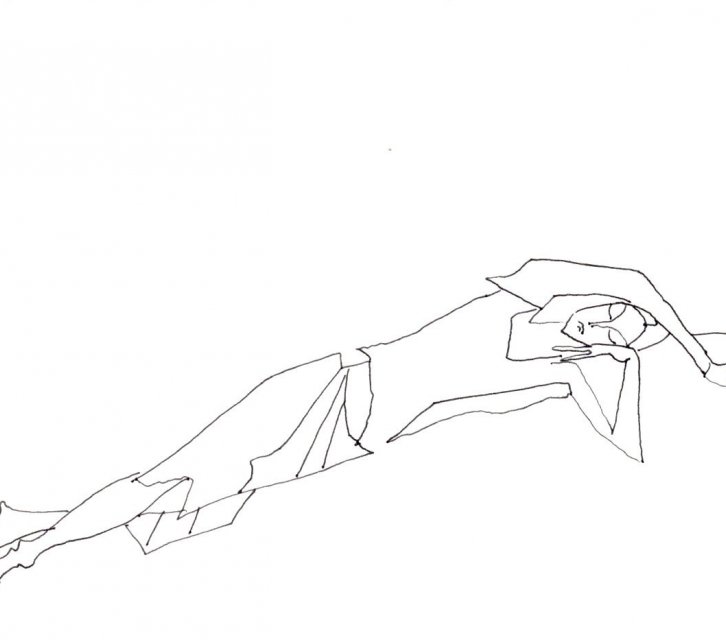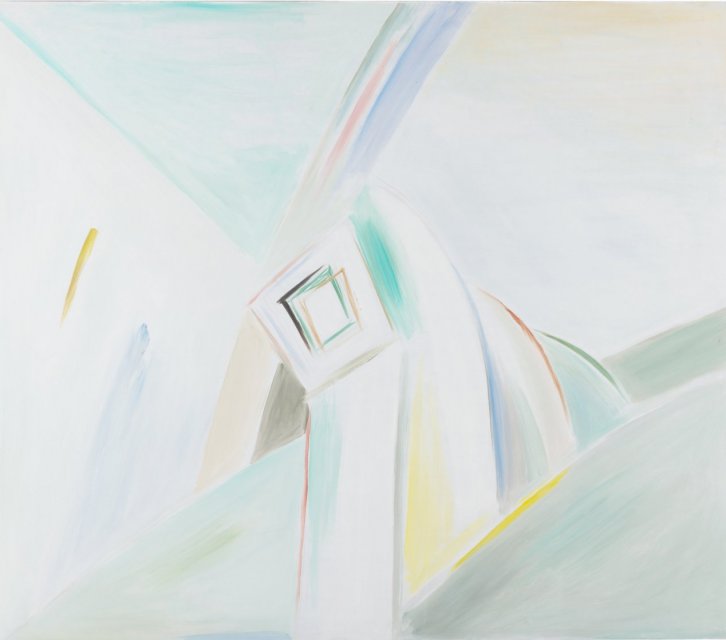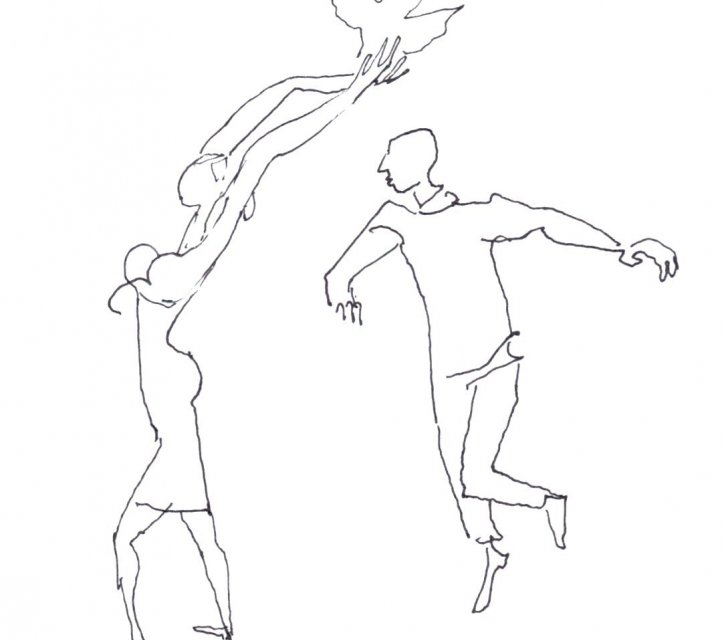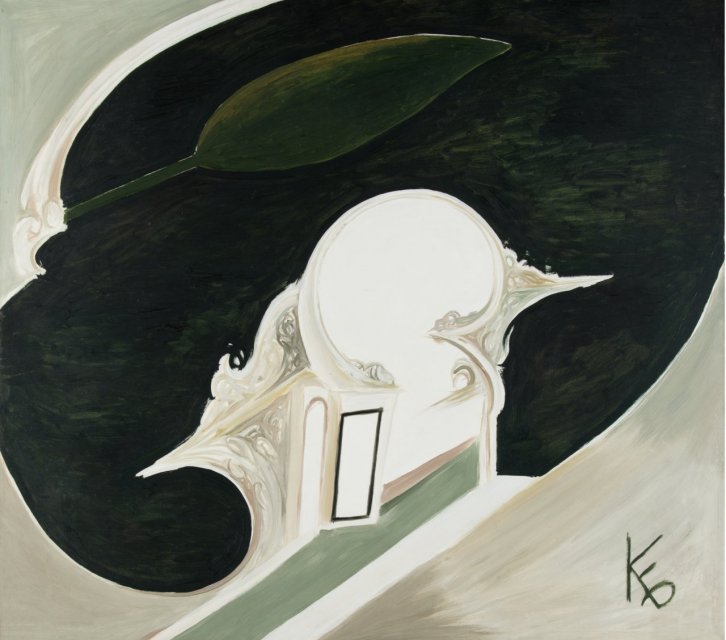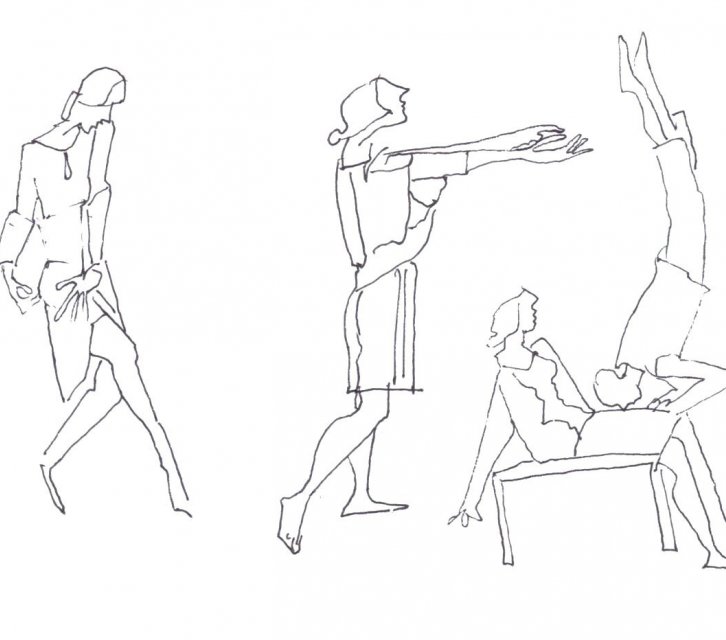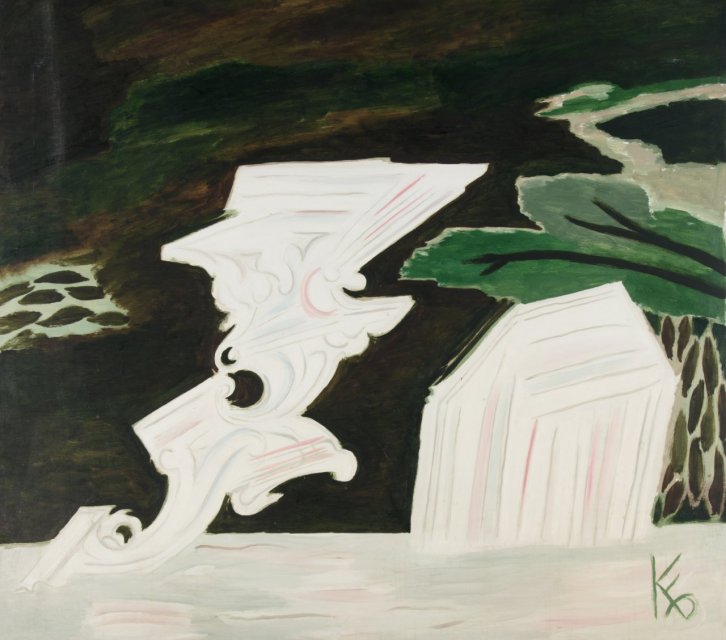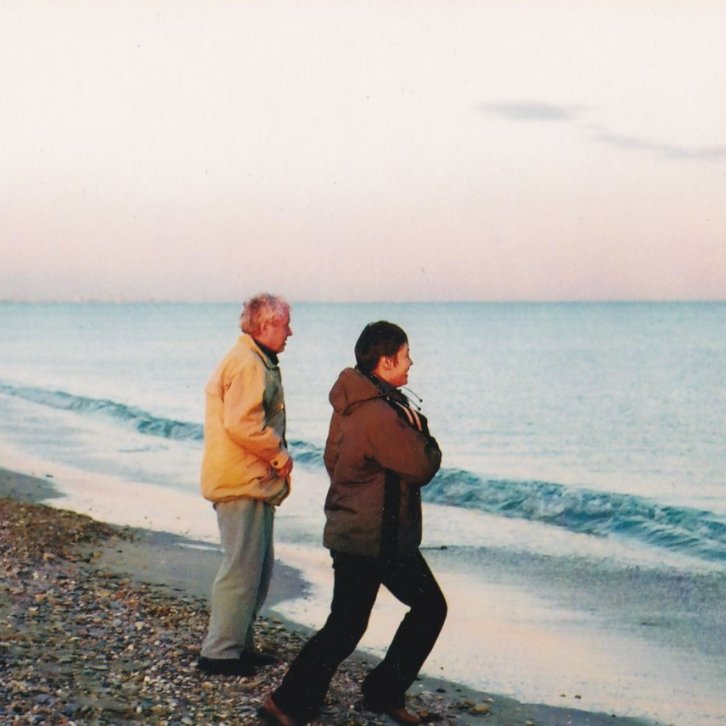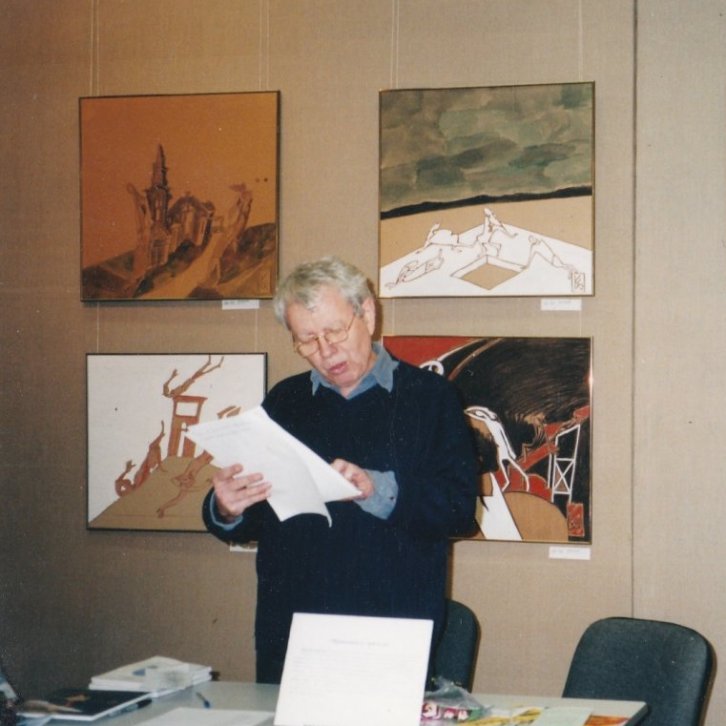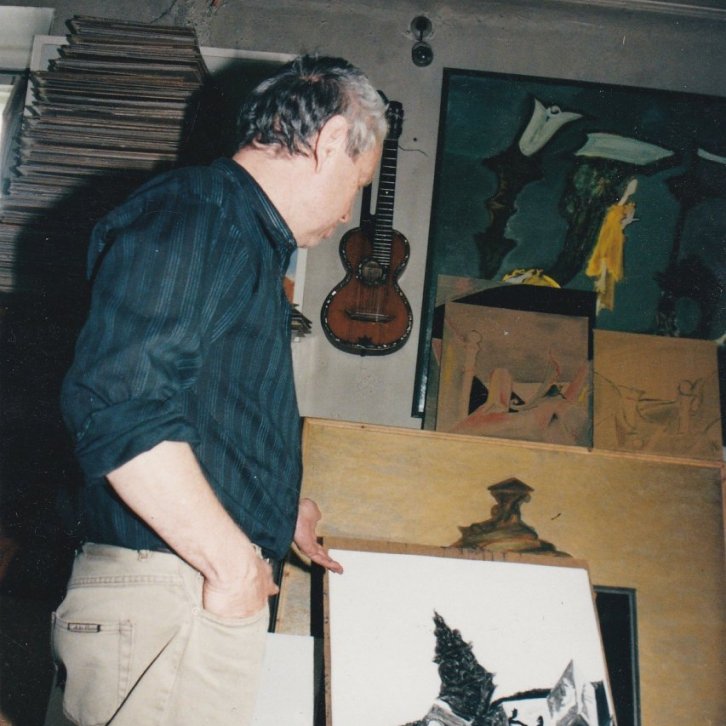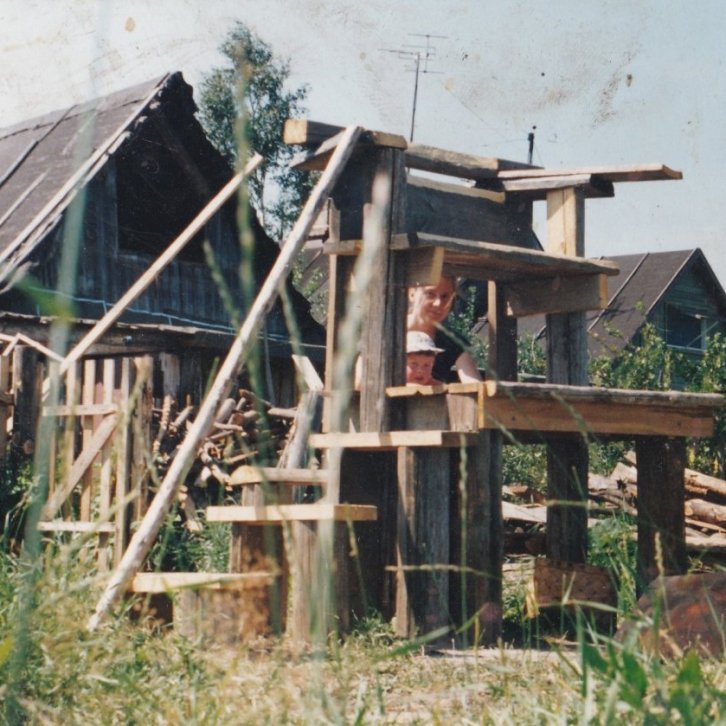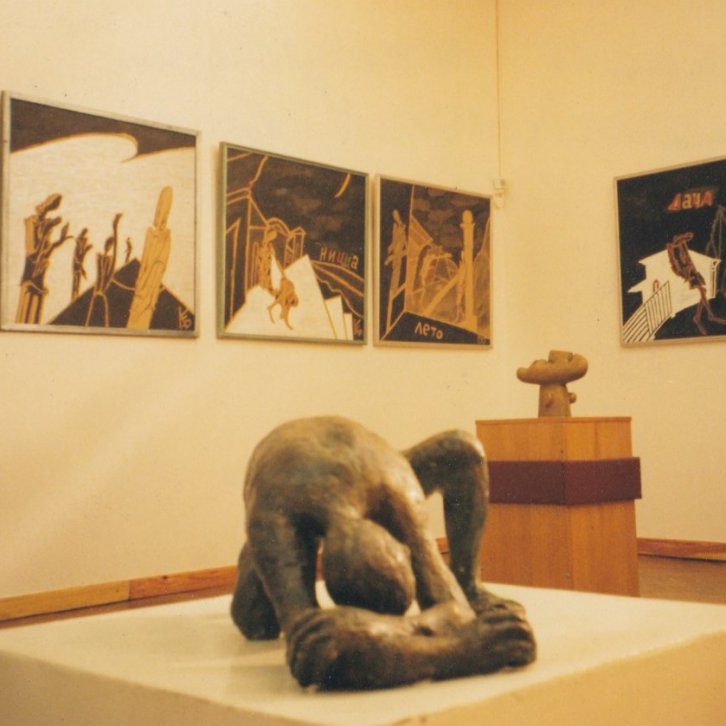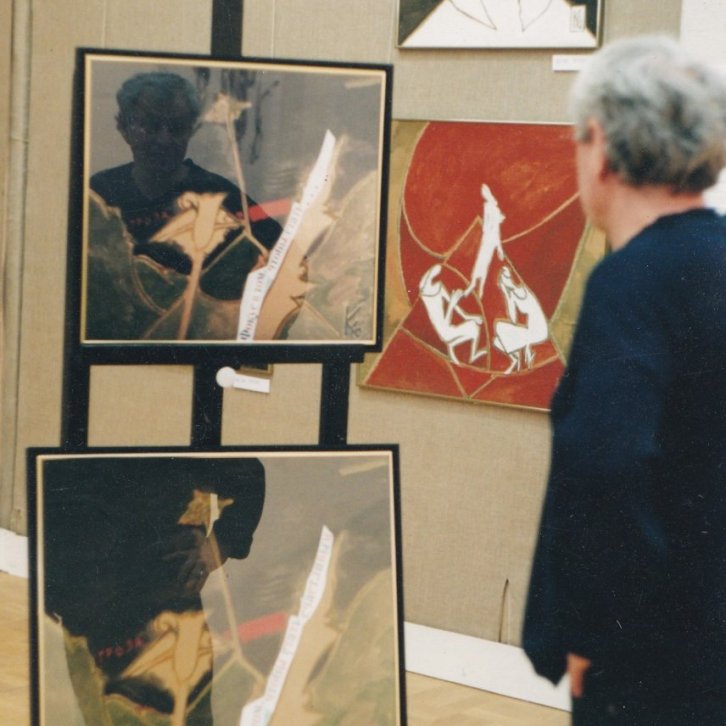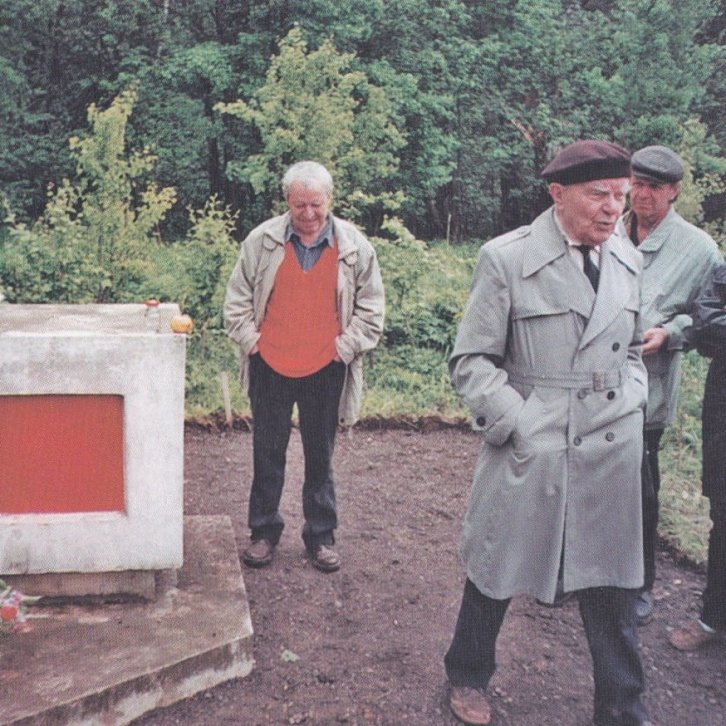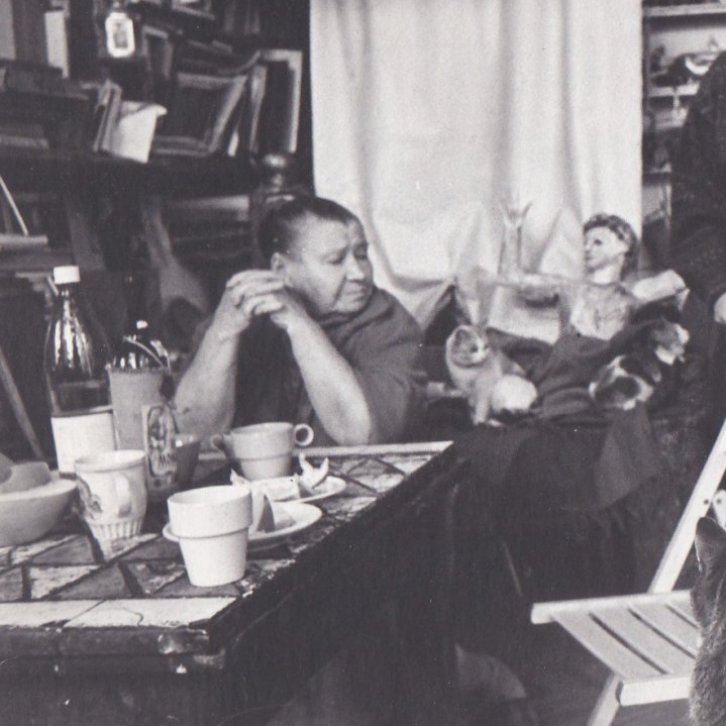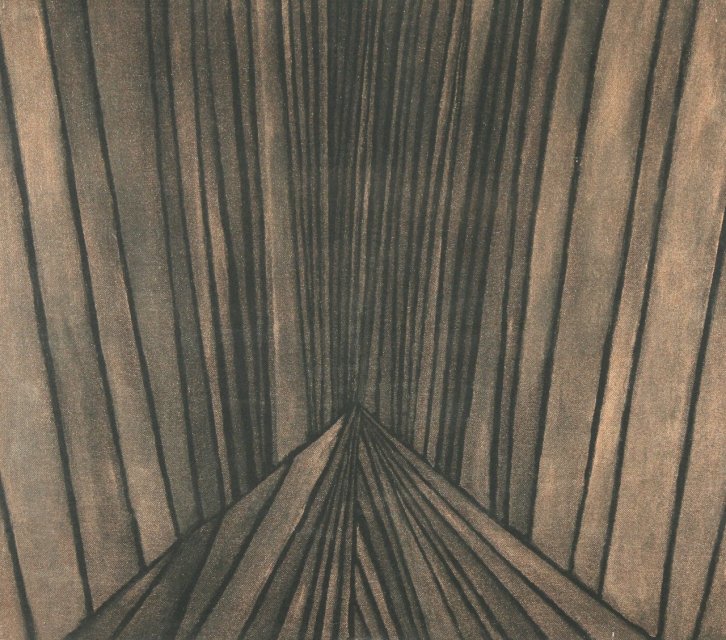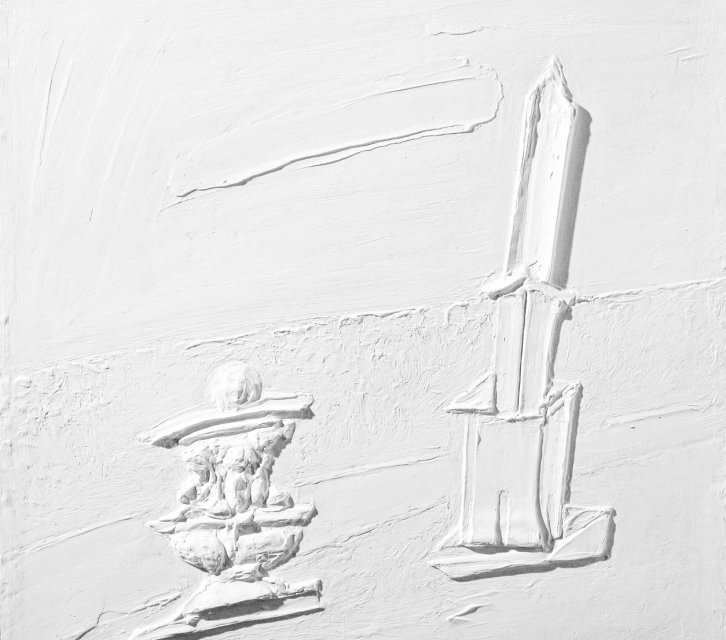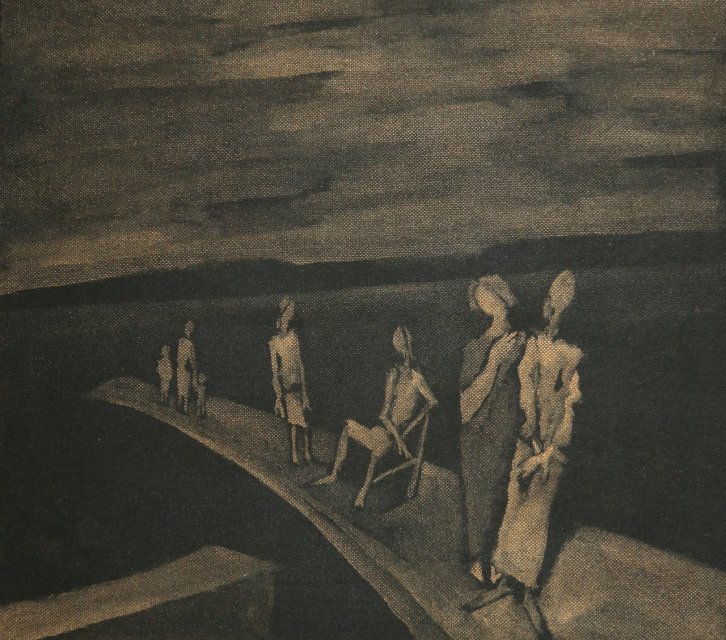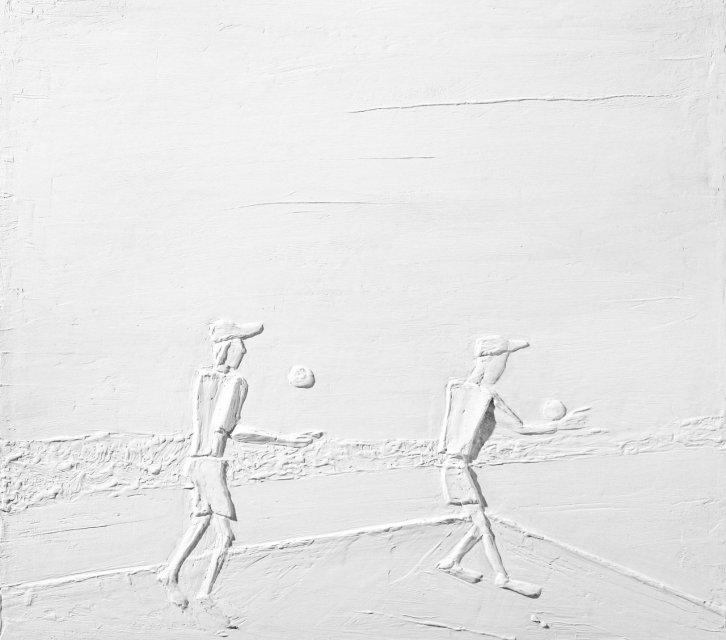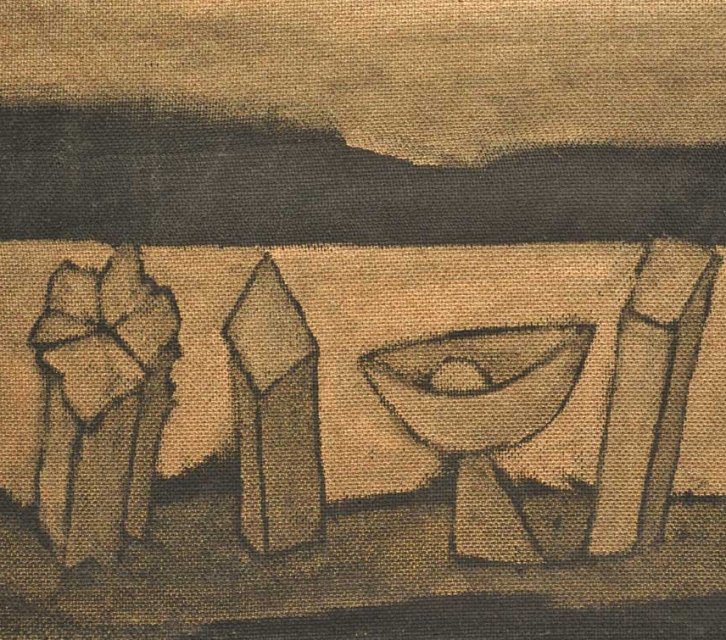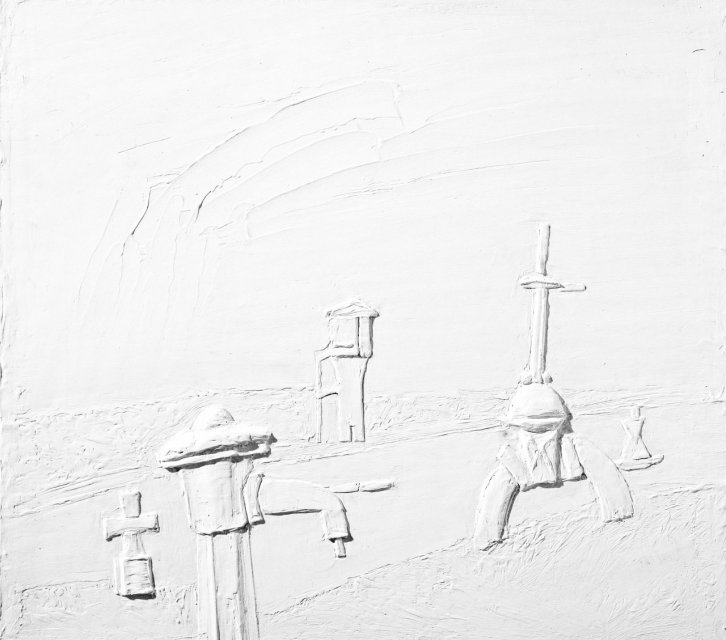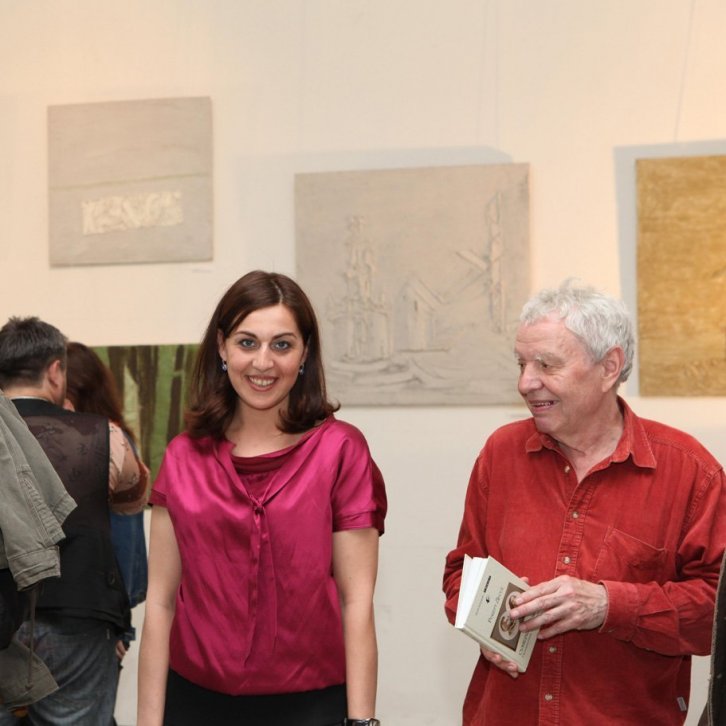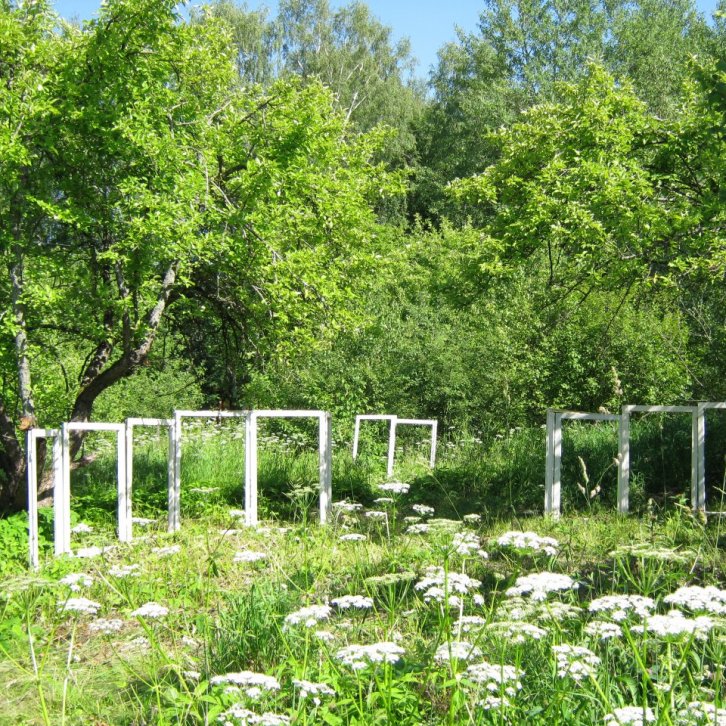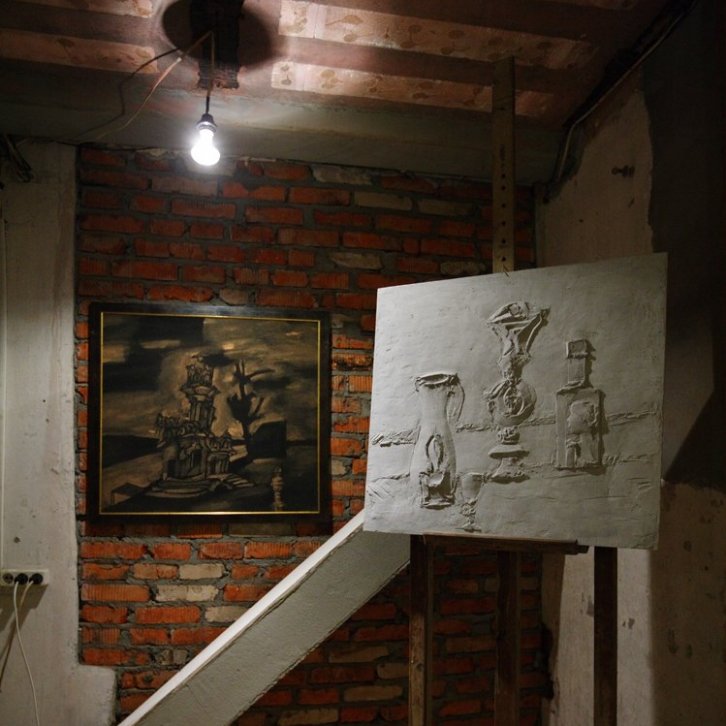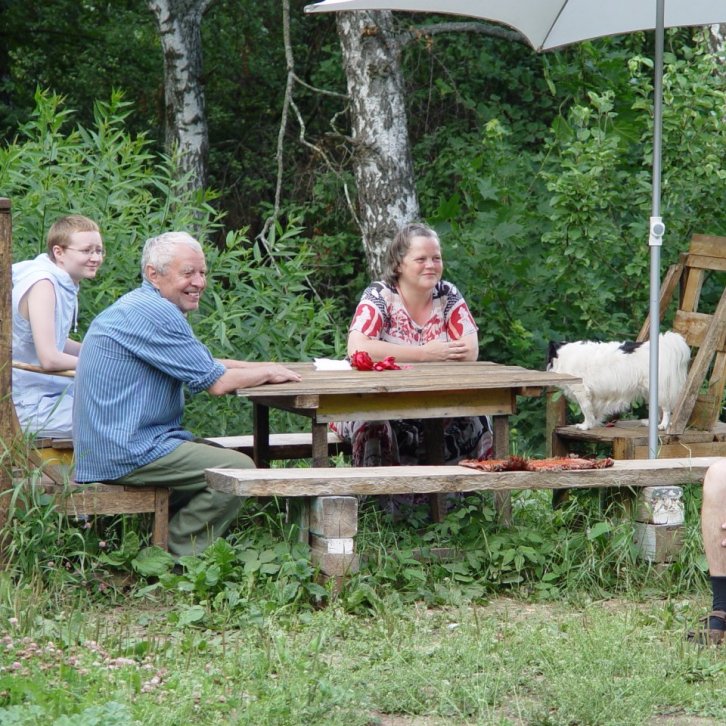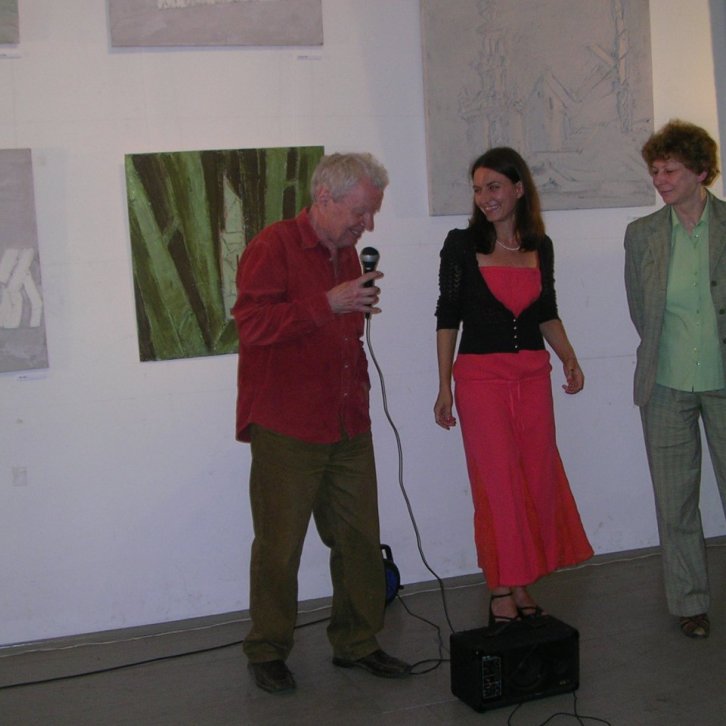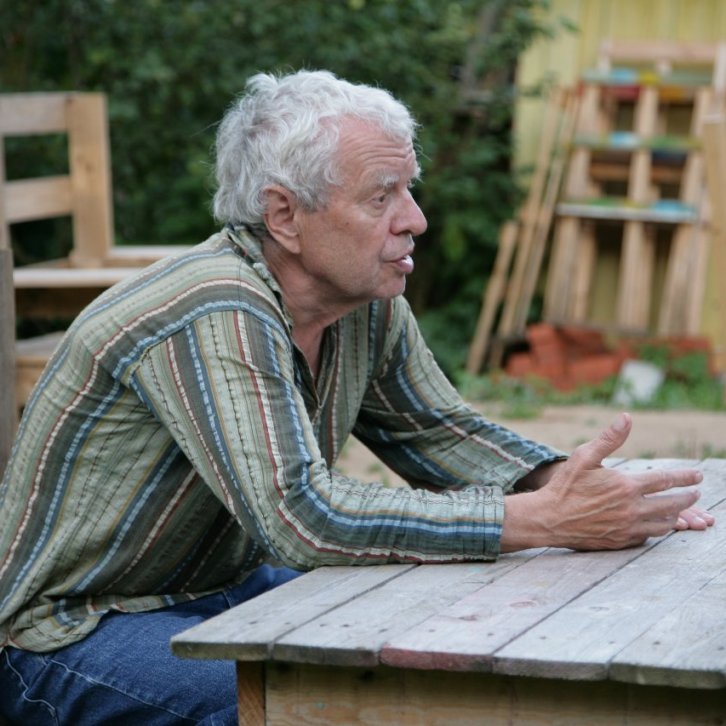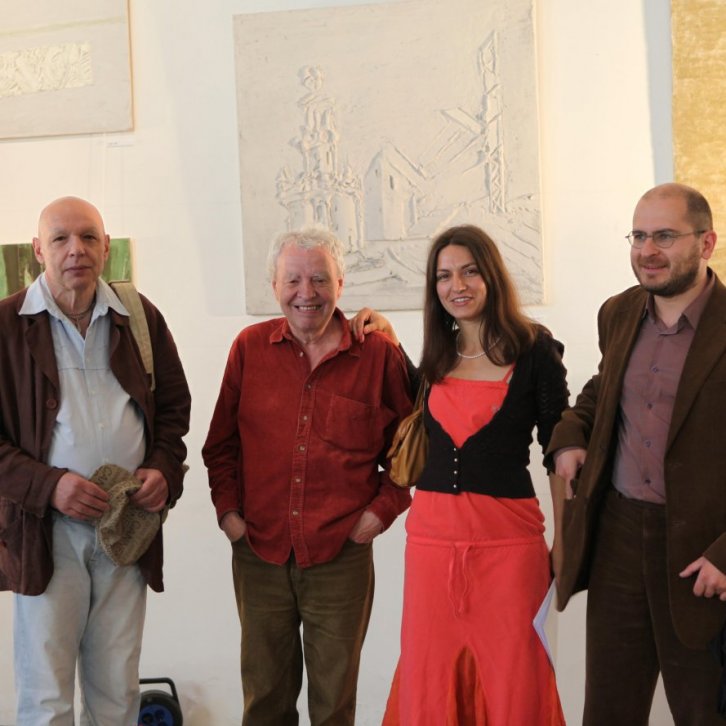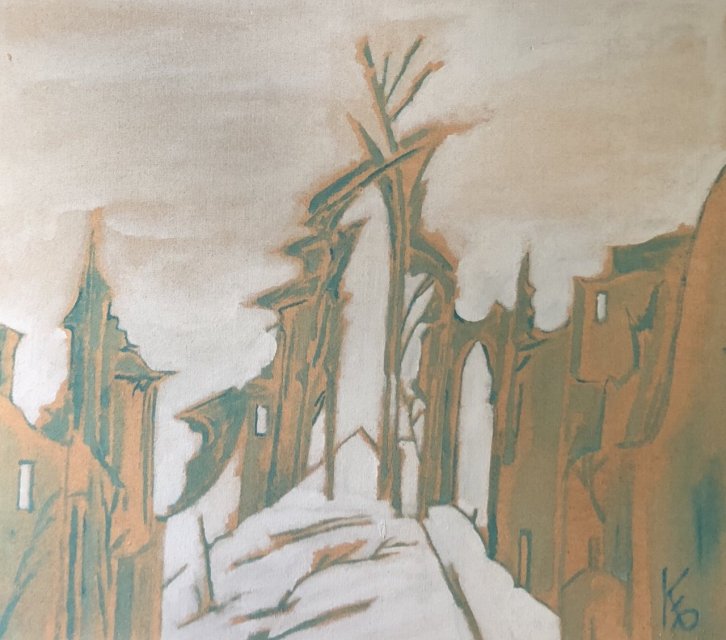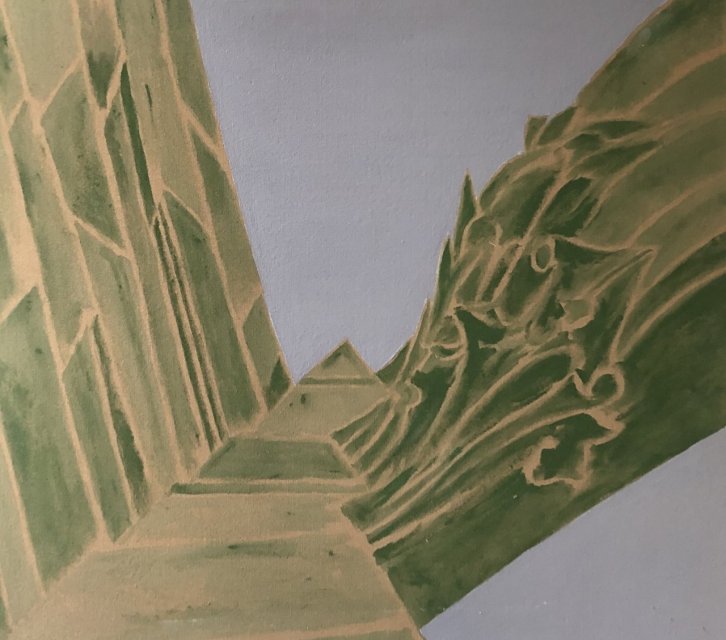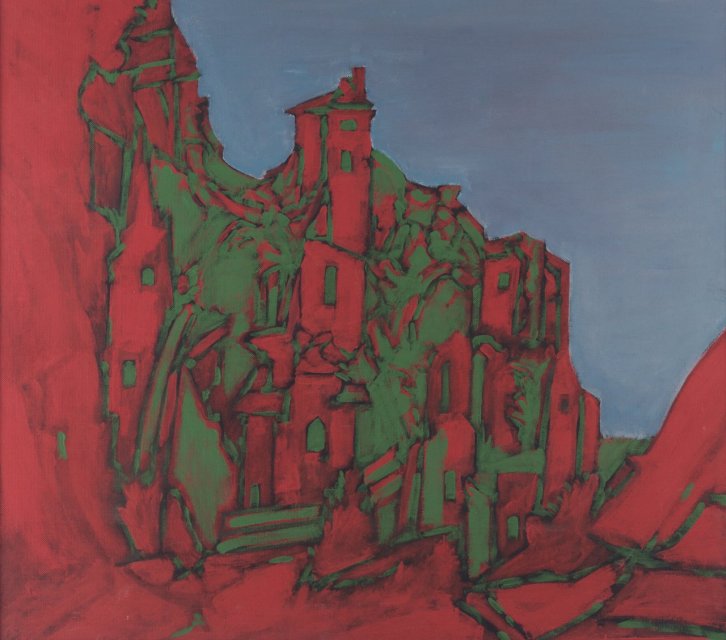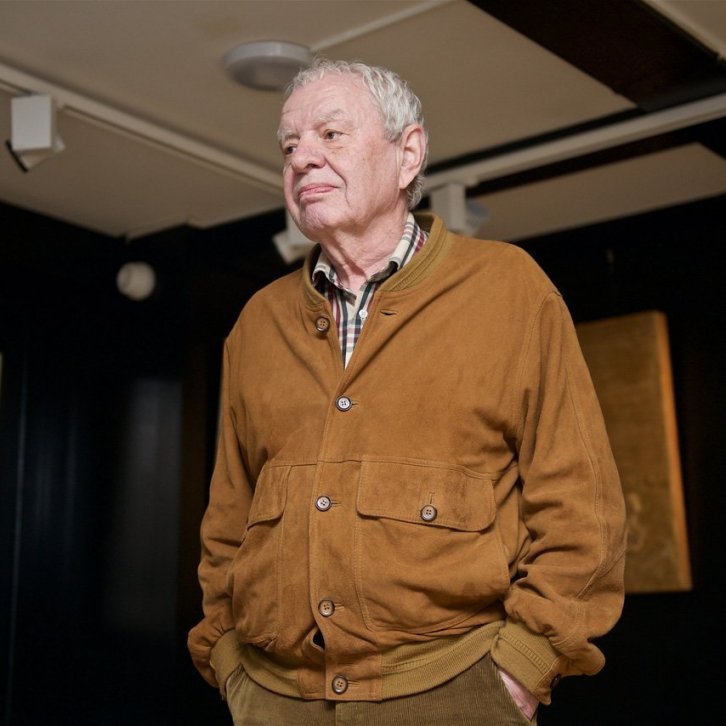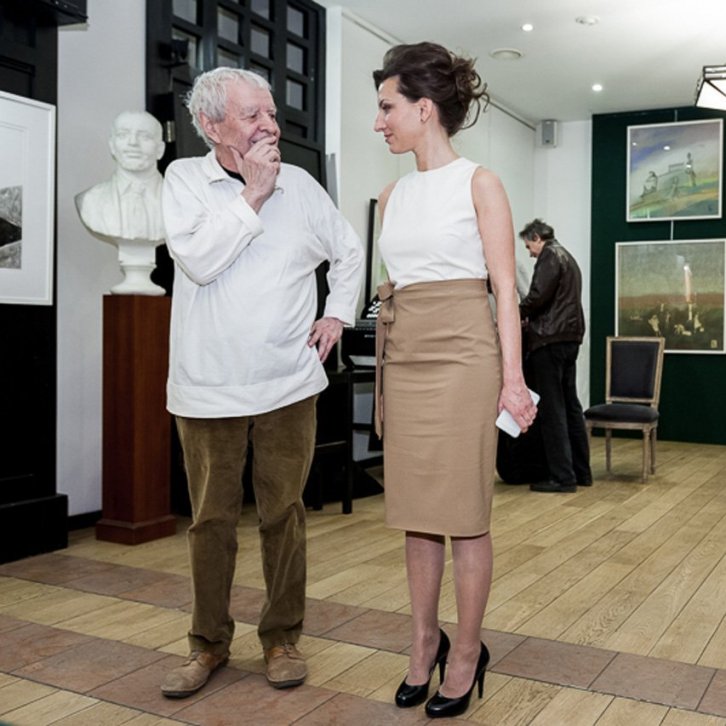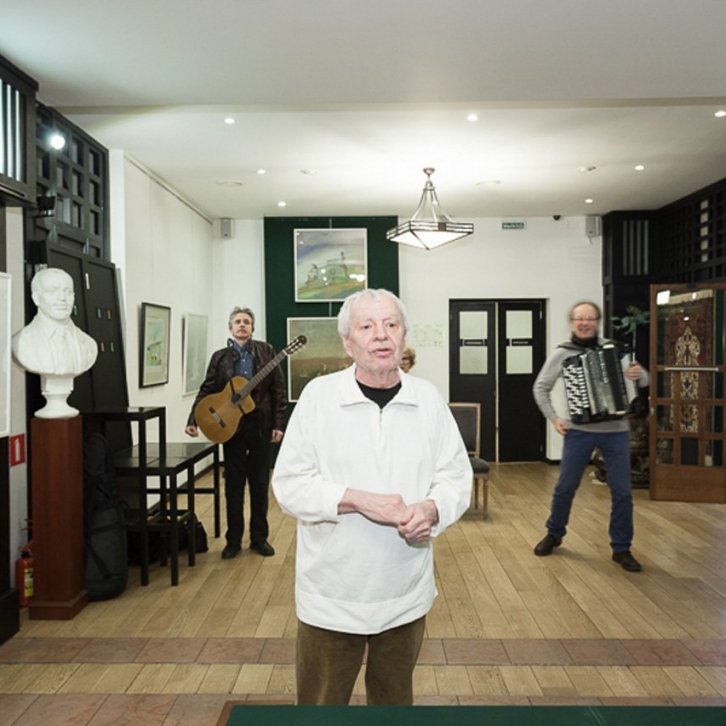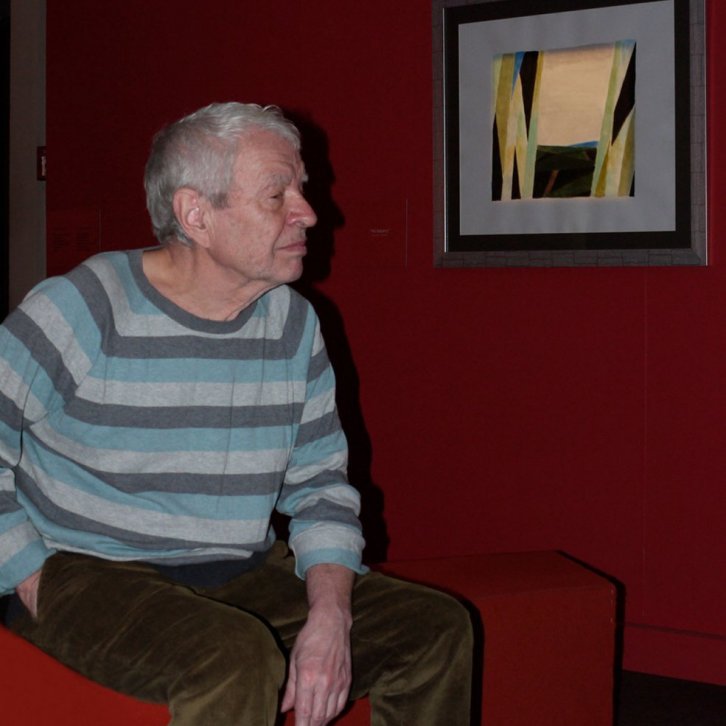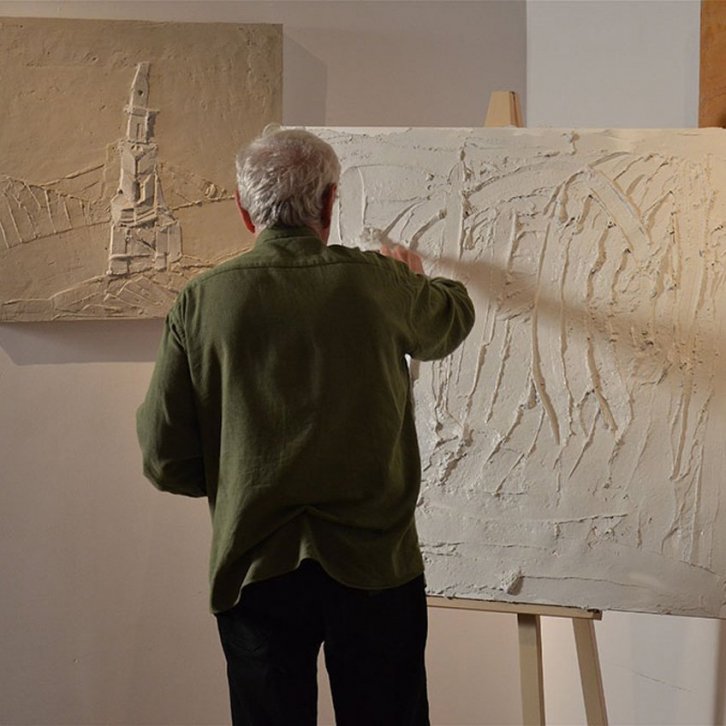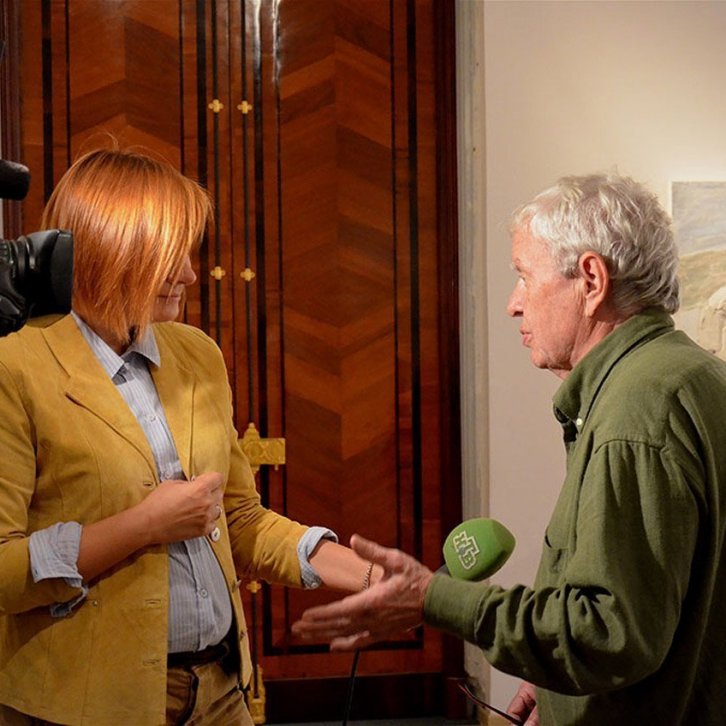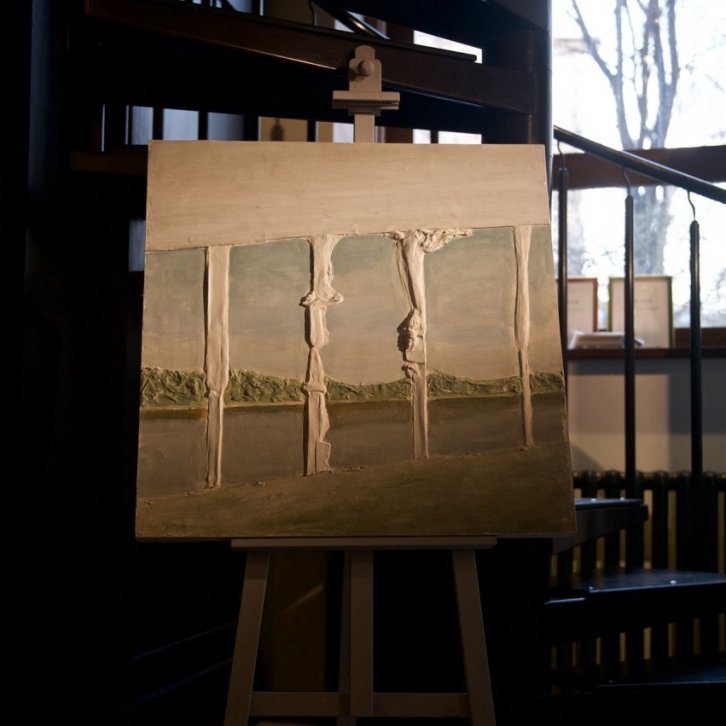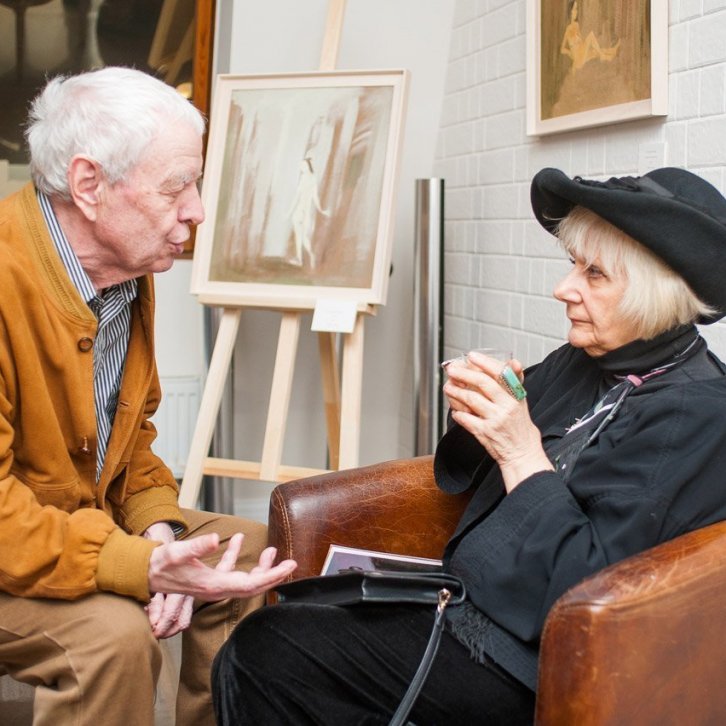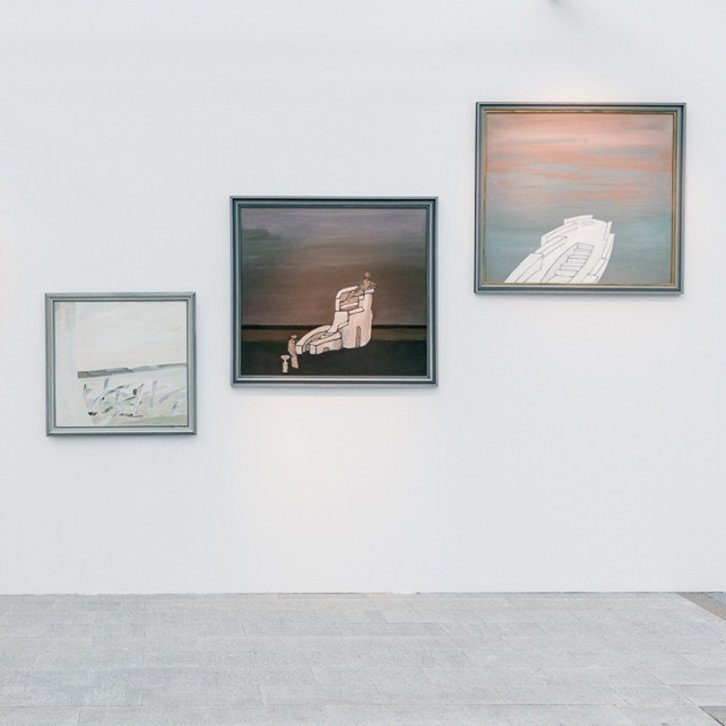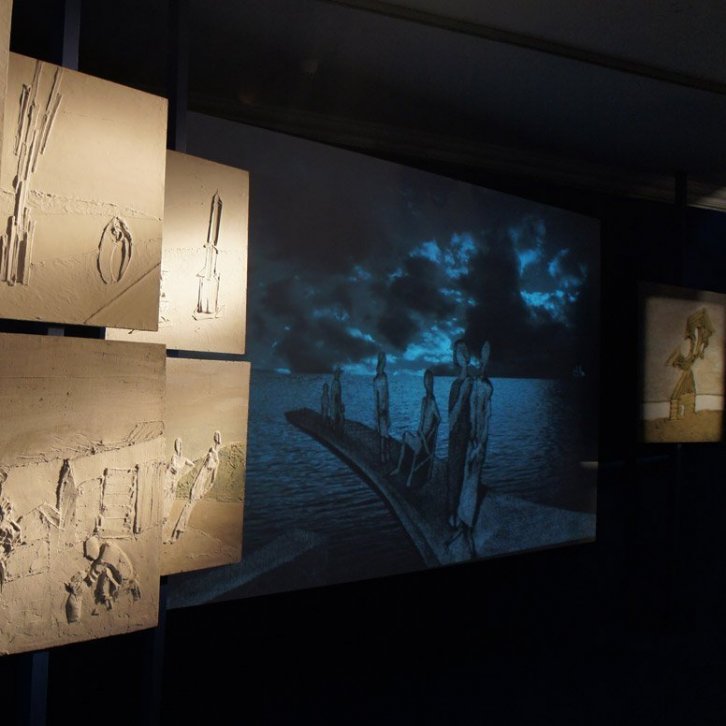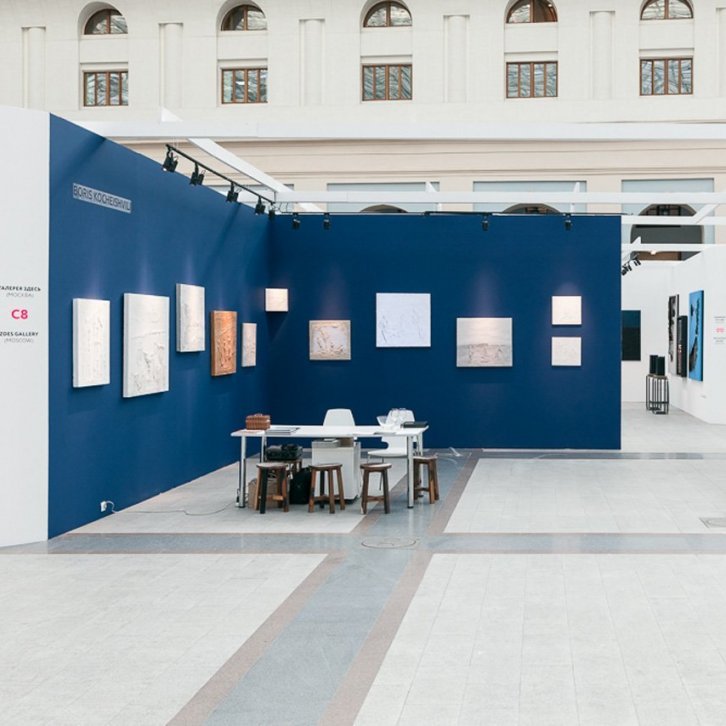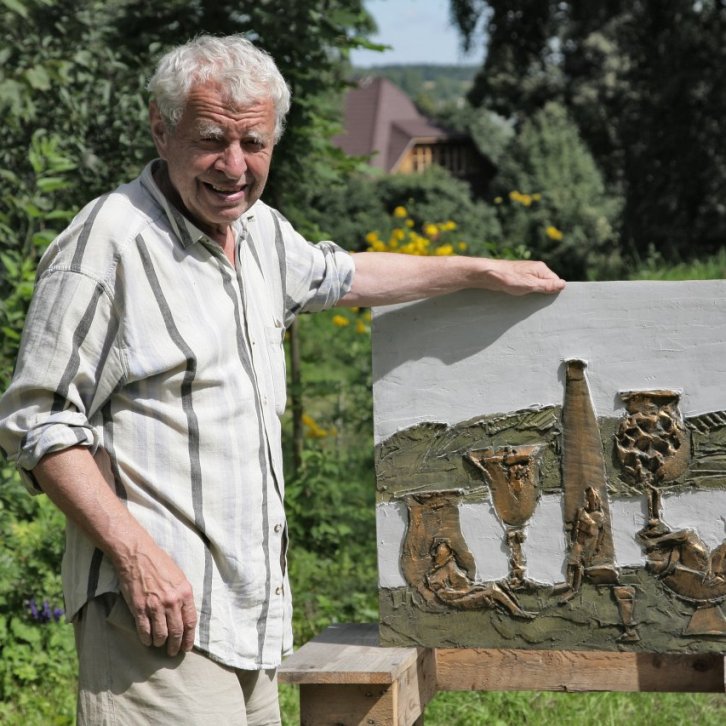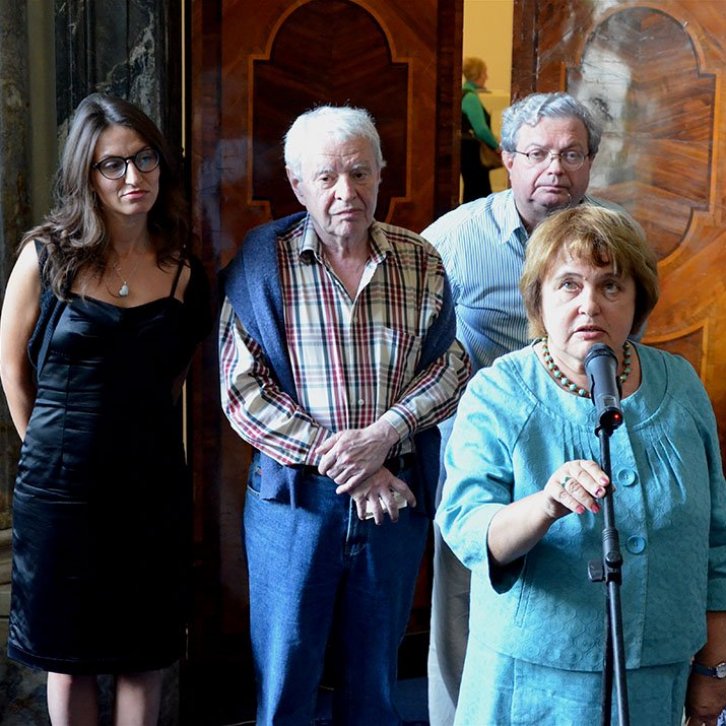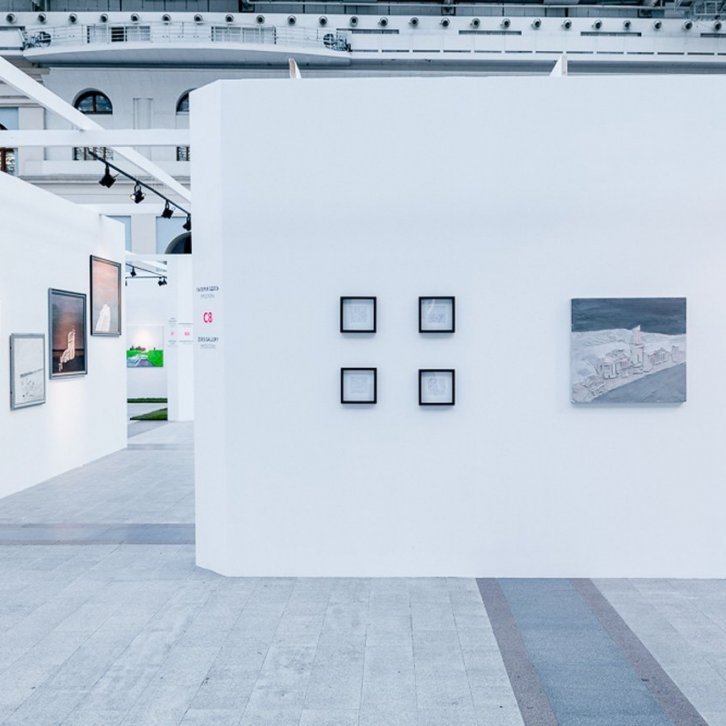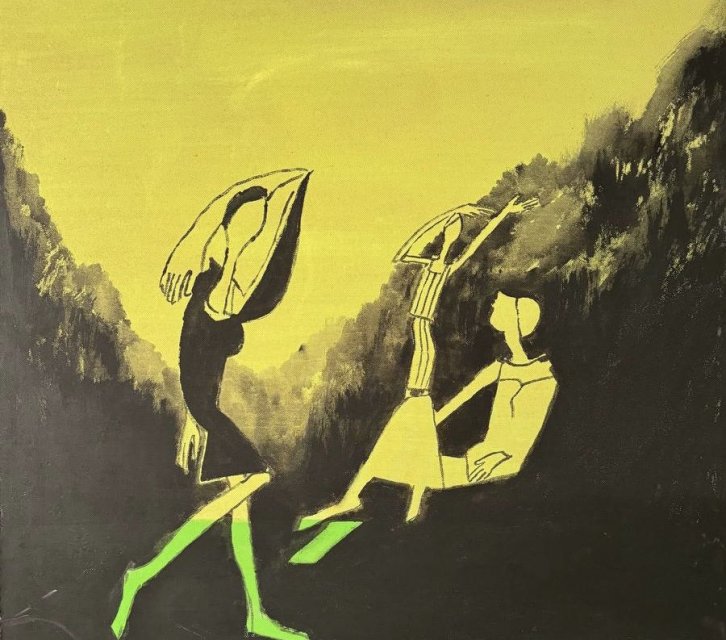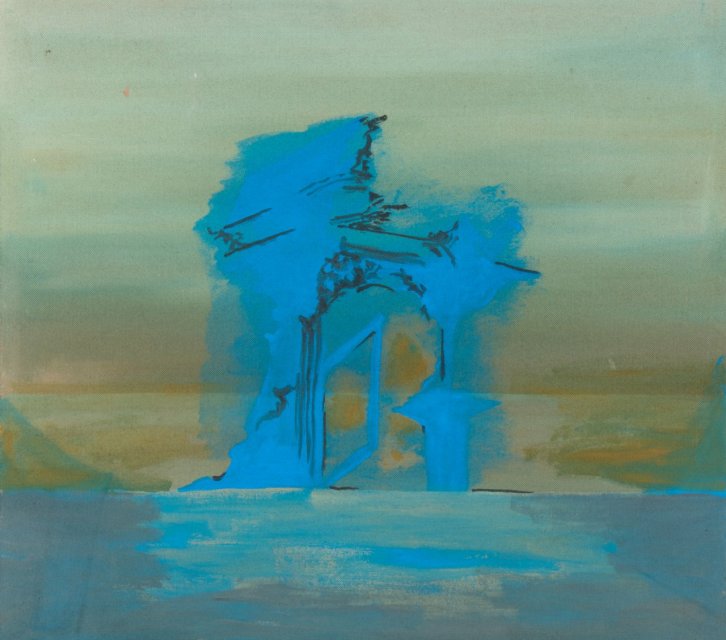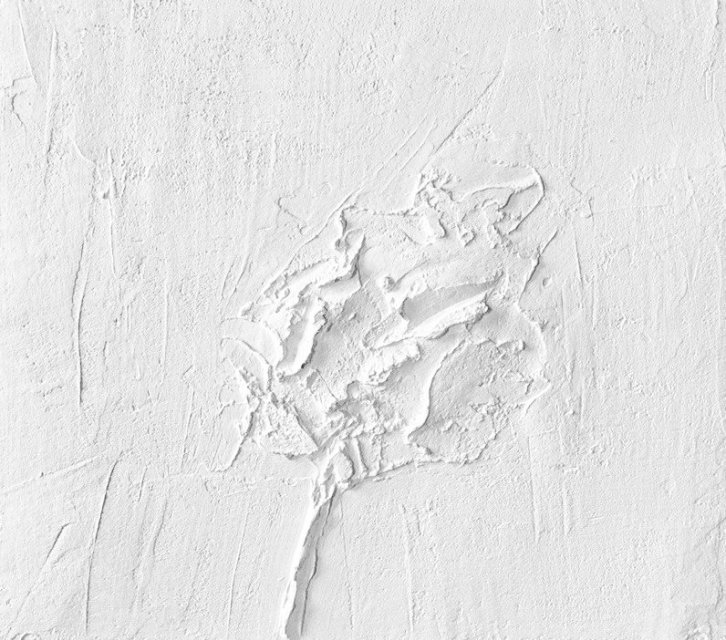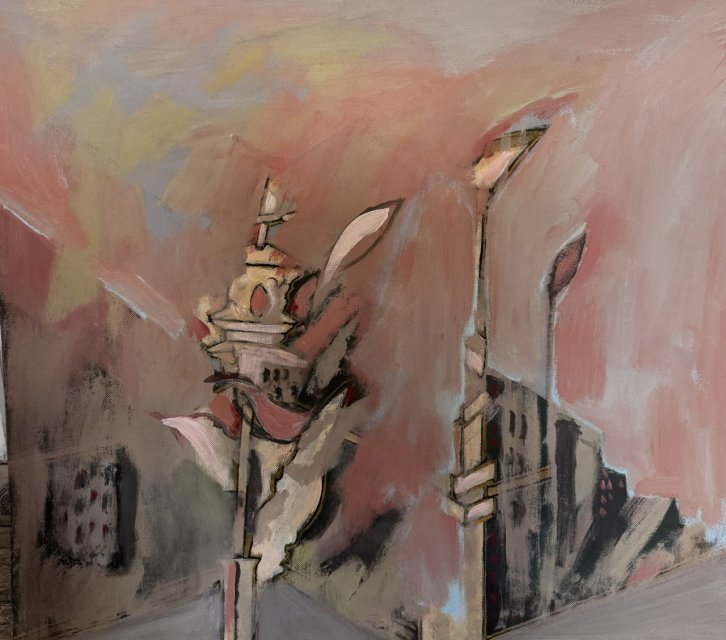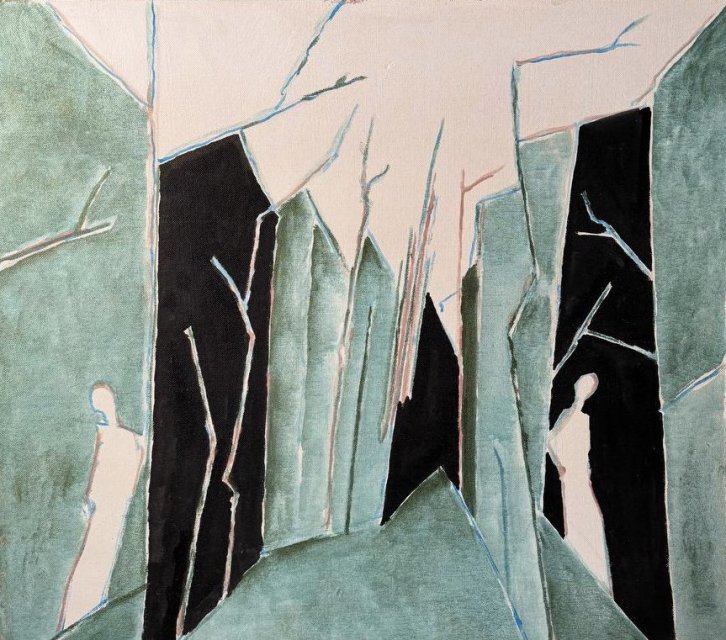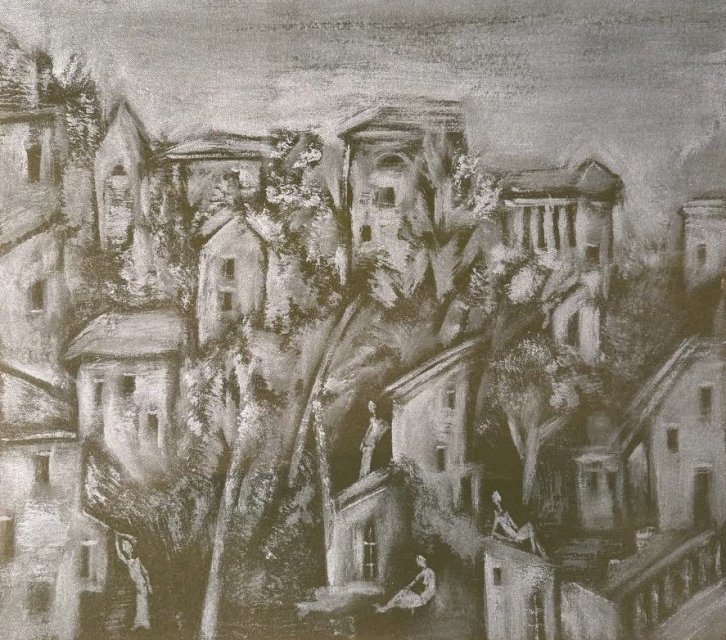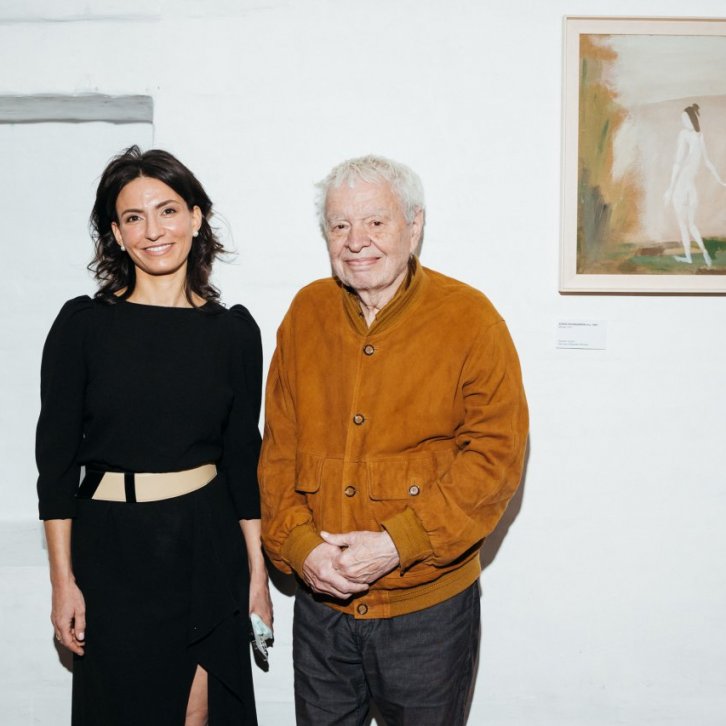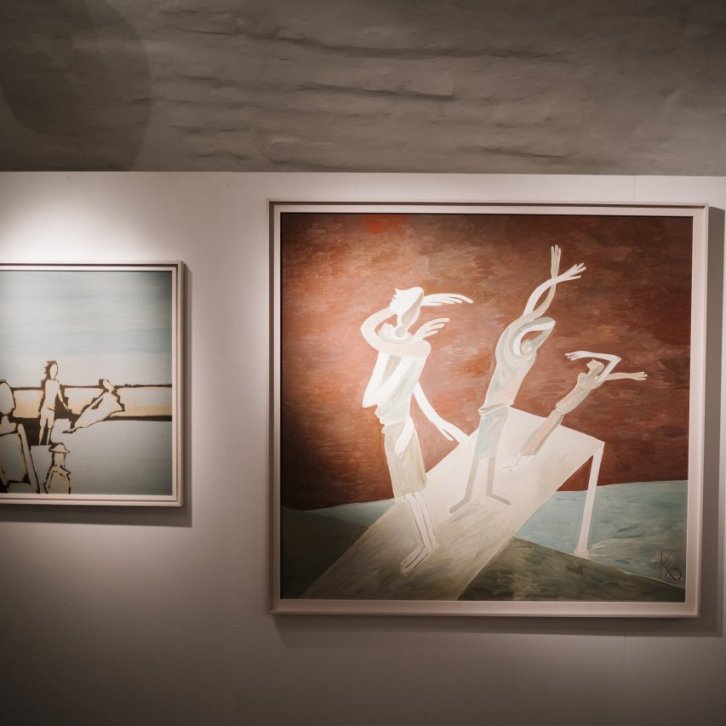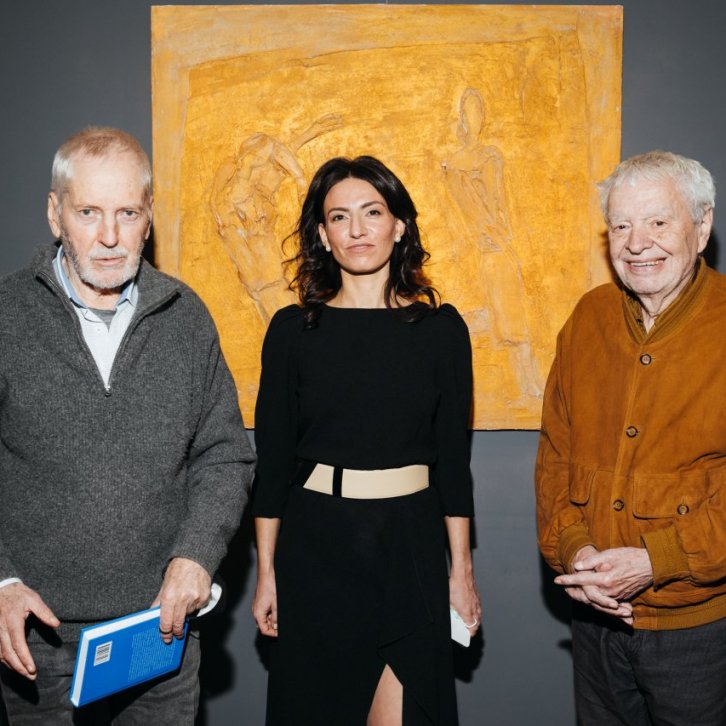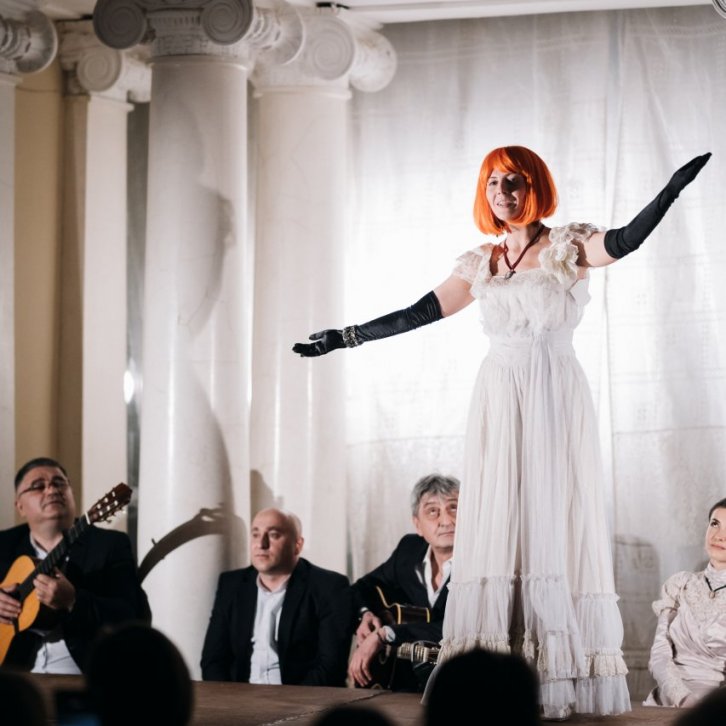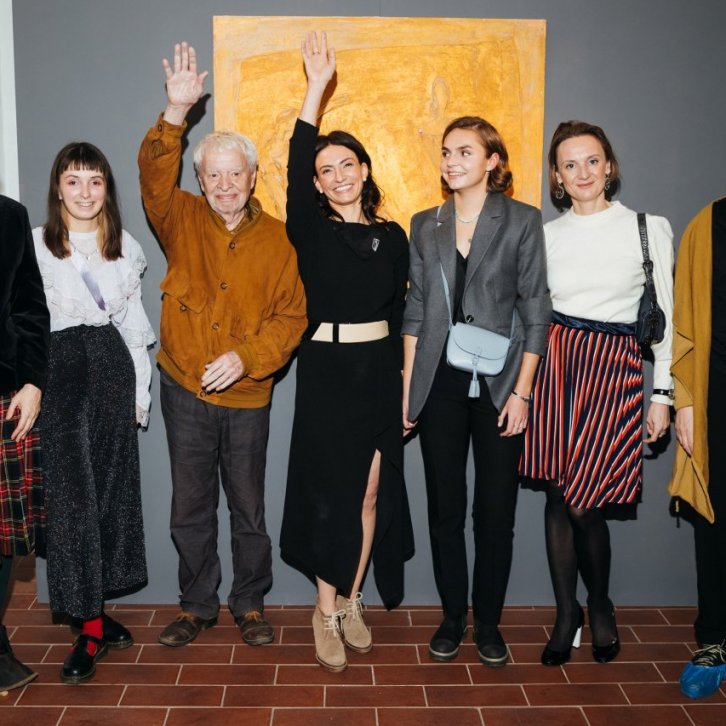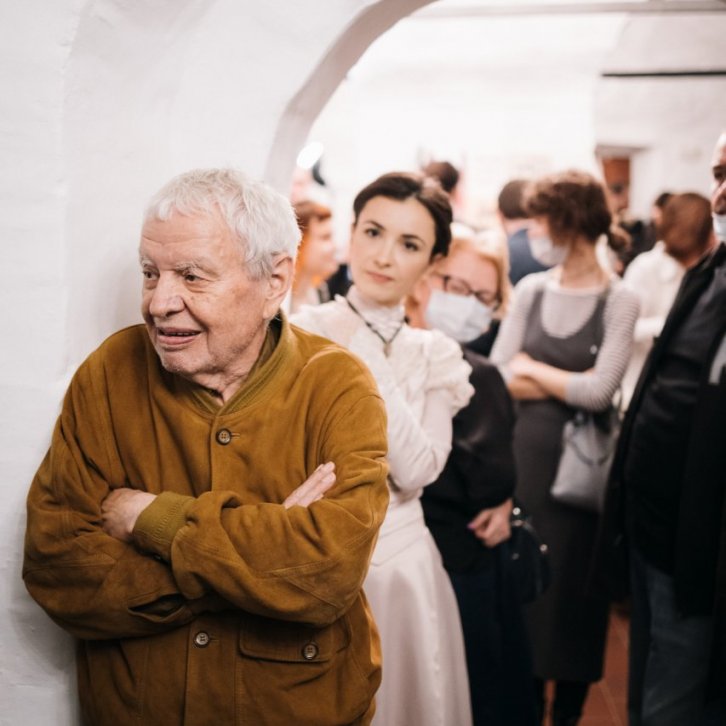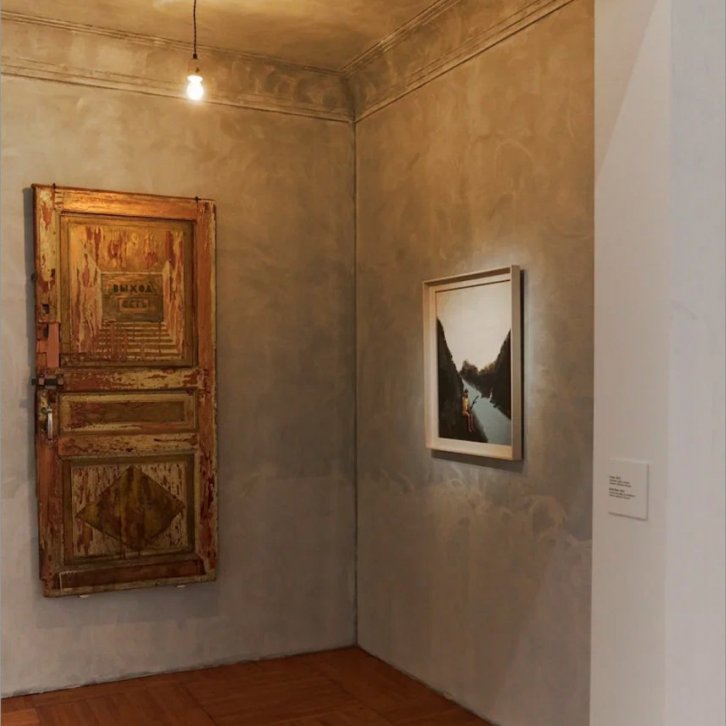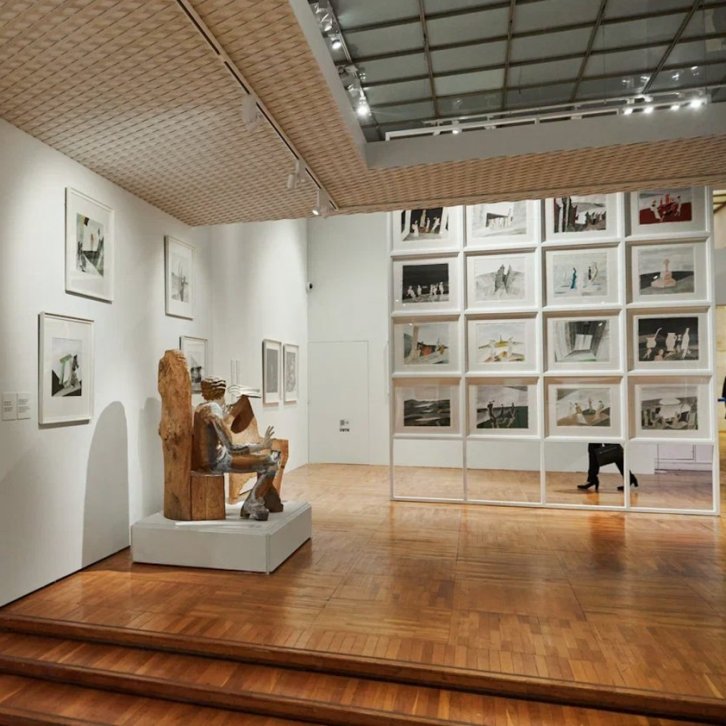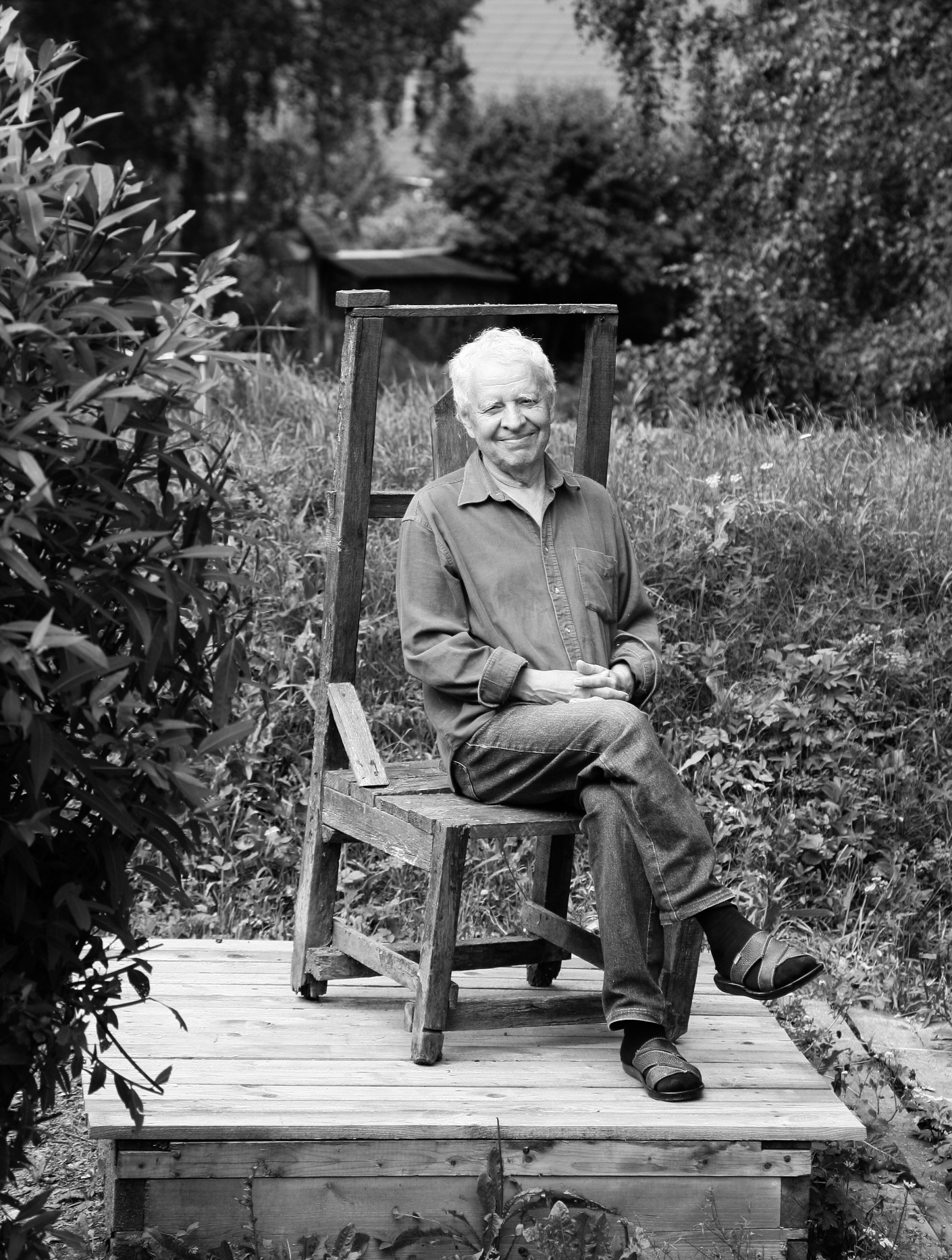
BORIS KOCHEISHVILI
The distinguished Moscow-based artist and poet is renowned for his prolific creative output in graphics and paintings, pioneering a novel form of a classical easel sculptural relief. Today, all these types of works are represented in a number of leading museum collections. His poetry has earned him a place among the acknowledged names of Russian avant-garde literature and is regularly featured in literary magazines and almanacks.
Kocheishvili’s art, engaged in a dialog with a Western cultural tradition, created a context of its own, drawing influences from old Russian icon painters to Pirosmani and Picasso. The theatrical nature of his works is inspired by the mise-en-scenes from Shakespeare and Chekhov. The inadvertent minimalism of his artworks echoes the essence of minimalist poetry. At the same time, his art is contemporary and vibrant, reflecting his era, its profound images, and meanings. Kocheishvili invented an original artistic language, his hand, style, and alphabet are instantly recognizable. Boris Kocheishvili is a solitary artist who did not join any artistic associations and movements of his time; his statement has yet to be understood in the context of the era.
Boris Kocheishvili was born in 1940 in Elektrostal, a small industrial town in the Moscow region. After graduating from the Moscow Academic Art School, he started to work at the Nivinsky art studio, where he was mentored by Evgeny Teis and developed a keen interest in experimenting with printed graphics.
In 1981, his works were put on display at the “Exhibition of Works by Twenty-Three Moscow Artists” at the Central House of Artists in Moscow. This exhibition was one of the first major showcases in the USSR to feature artworks not officially sanctioned by the Soviet art establishment. Later some of his works from that exhibition were purchased by the State Tretyakov Gallery.
By 1986, his artworks were being presented worldwide. American gallerist Phyllis Kind first showcased Kocheishvili's art at the Chicago International Art Fair and in 1987 included his pieces in the exhibition “Direct from Moscow!” at her New York gallery along with works of Erik Bulatov, Oleg Vasiliev, and Semyon Faibisovich. In 1988, the artist's graphics were featured at the FIAC art fair in Paris, France.
In the 2010s and 2020s, Kocheishvili held several retrospective solo exhibitions at major museums. In 2013, he presented “Simple Summer” at the State Russian Museum in St. Petersburg, and in 2017, he had a solo exhibition at the Tbilisi MOMA.
The State Tretyakov Gallery in Moscow hosted the major solo exhibition “Boris Kocheishvili. Me and Them” in 2021. This exhibition, the comprehensive study of the artist’s works, was accompanied by a set of interactive multimedia close-ups.
Kocheishvili’s artworks are included in the collections of the State Tretyakov Gallery (Moscow), the Pushkin State Museum of Fine Arts (Moscow), the State Russian Museum (St. Petersburg), AZ Museum (Moscow), Alberto Sandretti Foundation (Milan), Stiftung Arina Kowner (Zürich), and more than twenty other regional museums and private collections.
Selected group exhibitions and art fairs:
2015
NEW ADDITIONS 1998 - 2014. The State Russian Museum, St. Petersburg, Russia.
2013
Russian Relief of XVIII – beginning of XXI centuries. From the collection of the State Russian Museum. St. Petersburg, Russia.
2012
Without Barriers: Russian Art of 1985-2000. The State Russian Museum. St. Petersburg, Russia.
2011
Transition from the Soviet Union to Russia: Passion and Painting in Russia Since 1970. Museum of Fine Arts. Bern, Switzerland.
2000
Art-Brussels fair. The New Collection Gallery stand. Brussels, Belgium.
1988
FIAC. Paris, France.
1987
Direct from Moscow! Phyllis Kind Gallery. New York, USA.
1986
Chicago International Art Fair. Chicago, USA.
1981
Exhibition of the 23. CHA (Central House of Artists). Moscow, Russia.
1963
The Second Exhibition of Moscow Printmaking. The State Pushkin Museum of Fine Arts. Moscow, Russia.
Selected solo museum exhibitions:
2021
Boris Kocheishvili. Me and Them. The State Tretyakov Gallery. Moscow, Russia.
2021
Me and Them. Three Sisters. The Moscow Art Theater Museum. Moscow, Russia.
2017
Polyphony. MOMA Tbilisi. Tbilisi, Georgia.
2013
Simple Summer. The State Russian Museum. St. Petersburg, Russia.
Selected publications:
Boris Kocheishvili. Me and Them / Exhibition catalogue. Moscow, 2021.
Boris Kocheishvili. Polyphony / Exhibition catalogue. МОМА. Tbilisi, 2017.
Boris Kocheishvili at The State Russian Museum / Exhibition catalogue. St. Petersburg, 2013.
Boris Kocheishvili. Graphics, Painting, Reliefs. Our Heritage. Moscow, 2010.
And more than 20 issues in various publications.
Artist's catalogue
The catalogue for the solo exhibition at the State Tretyakov Gallery offers the most comprehensive collection of the artist’s work to date.
This monograph covers every period and medium explored by the artist, along with a detailed biography, essays by leading art historians and critics, and a selection of poems by Kocheishvili.
Essays by Kirill Svetlyakov, Galina Elshevskaya, Alexander Borovsky, Simon Hewitt, and others featured in the catalogue can be read on our website in the “Texts” section.
In 1962, Boris Kocheishvili graduated from the Moscow Academic Art School. During this decade, he interacted with numerous figures from the Russian avant-garde scene.
In 1964, he was accepted as a candidate member of the Union of Artists of the Moscow region.
In 1965, Boris traveled to Italy with a group of young artists. Reflecting on his time in Rome, he said, “Rome was like a surreal dream! We were only there three days, and the museums were overwhelming. We dashed through them, but it was impossible to take it all in. It was like being given a barrel of honey – you could eat a spoonful, but the second one was just too much. And that was just the honey!” While in Rome, Kocheishvili got introduced to contemporary Western artists, including Lucio Fontana, Tachisme, and a few others. Florence left a lasting impression on him, particularly Benvenuto Cellini's sculpture of Perseus. In Venice, he spent all his money on art books, which he later gave to friends when he returned to the USSR.
In 1965, he started working at the Graphic Experimental Studio, where he developed a passion for experimenting with printed graphics. He spent a lot of time at the “Creative Houses for Artists” (community centers for artists run by the Union of Artists for its members), located in various regions of the USSR, where he honed his skills in different graphic techniques. Today, the etchings and lithographs he created during that time are in the collection of the Engraving Cabinet of the Pushkin State Museum of Fine Arts, and more than twenty other Russian museums.
During these years, Kocheishvili formulated his own distinctive “alphabet” – the foundation of his artistic language. Focusing on graphics, he created a world filled with delicate, tender and emotionally charged images. Women, architectural objects, totems, landscapes, and geometric abstractions filled Kocheishvili's expanding universe, and they continue to do so even today.
In the late 1960s, the artist tried his hand at painting and created a series of oil on canvas works.
These pieces are hard to come by today, and we would love to learn where they are now.
- Works
- Texts
- Events
- Photos & Videos
- Manuscripts






1964 – Boris Kocheishvili was accepted as a candidate member of the Union of Artists of the Moscow region.
1965 – He started working at the Nivinsky art studio, where he developed a passion for experimenting with printed graphics.
1966 – The artist took part in the exhibition of Moscow printmaking at the Pushkin State Museum of Fine Arts. One of Kocheishvili’s works illustrated entry tickets.
1969 – The “Pushkin” series of works was displayed at the third zonal exhibition “Center – Northern regions” in Smolensk.
Boris continued his work at the I.I. Nivinsky Experimental Studio and in 1972 he held his first solo exhibition of over 100 drawings.
Around this time he created a series of brush drawings on coated paper. These years marked the development of his inimitable style, which featured metaphysical still life and landscapes, portraits of family and friends, and genre scenes. One of his key themes was the theater
The artist also took part in regional and all-Union exhibitions, showcasing his graphic series like “Pushkin” and “My Contemporaries”.
- Works
- Texts
- Events
- Photos & Videos
- Manuscripts
The Central House of Artists hosted the “Exhibition of Works by Twenty-Three Moscow Artists” in 1981, which was the first official show of the “left-wing MOSKh”. The State Tretyakov Gallery acquired 15 of Kocheishvili’s graphic works.
In 1986, Kocheishvili’s art went global when American gallerist Phyllis Kind showcased his pieces at the Chicago International Art Fair, where all twelve of his black-and-white works were sold. That led to the exhibition “Straight from Moscow” at the Phyllis Kind Gallery in New York, participation in the FIAC exhibition in France, and a solo exhibition in Brussels. During this time, Boris Kocheishvili was more involved in the theater and film circles, thanks to his marriage to the famous soviet actress Lia Akhedzhakova. Another outcome of this union was the integration of the theater stage into his artwork. His dacha in Peredelkino became a gathering place for actors and writers, where Boris created portraits of cultural figures like Lia Akhedzhakova, Inna Churikova, and Fazil Iskander.
By the late 1980s, he had shifted to working with color, using watercolors, pastels, and oils, and delving into sculpture and relief art. His love for sculpture was influenced by his friendship with Adelaide Pologova, leading him to develop his unique style of low-relief sculpture art. Boris Kocheishvili is the only Russian artist who consistently uses the technique of colored relief. Kocheishvili's sculpture is expressed in two forms: monochrome and colored reliefs, as well as collages on paper and canvas that depict domestic wooden sculptures from the 18th century to the present day.
- Works
- Texts
- Events
- Photos & Videos
- Manuscripts
1981 – Boris Kocheishvili participated in the "Exhibition of works by twenty-three Moscow artists" at the Central House of Artists in Moscow. Fifteen works from the project were acquired by the State Tretyakov Gallery.
1986 – The artist’s works were shown at the Chicago International Art Fair by Phyllis Kind (New York).
1987 – He participated in the "Direct from Moscow!" exhibition at the Phyllis Kind Gallery in New York alongside Andrey Abramov, Eric Bulatov, Oleg Vasiliev and Semyon Faibisovich.
1988 – FIAC Contemporary Art Fair, Paris.
Late 1980s – his personal exhibition was held at Pile Gallery, Salzburg, Austria, organized with the support of the USSR Consulate in Salzburg.
Boris Kocheishvili had his first gallery exhibition in Moscow at the Mikhail Krokin’s Segodnya Gallery in 1991. However, just as his success was growing, he surprised everyone by leaving Moscow, moving to a remote village, and building a new life with his partner and a dog. During this time, he began writing poetry, publishing his first collection in 1992. His poetry, with its minimalism and clear imagery, is said to hold the key to understanding his artistic language.
Kocheishvili returned to Moscow a few years later and continued experimenting with new techniques, including pastels on corrugated cardboard, plaster reliefs, and his "black and gold" series, which consisted of small, often picturesque works that blended the rugged texture of the hardboard’s underside with the refined, almost mystical glow of gold paint against a black background. He also created the series “Names”, where text and images flow into each other.
His exhibition history in the late 1990s was quieter. Works by Kocheishvili were presented at a group exhibition at the Central House of Artists in 1995, he also participated in the “Moscow Artists Visiting Chagall” project at the Marc Chagall Museum in Vitebsk. In 1999, Mikhail Krokin showed Kocheishvili's works at his gallery “New Collection”.
- Works
- Texts
- Events
- Photos & Videos
- Manuscripts
1991 – an exhibition of the artist was held at the Krokin Gallery.
1992 – the first poetry collection «Two Houses» was published.
1995 – Kocheishvili’s personal exhibition was organized at the Central House of Artists, Moscow.
1998 – he participated in a group exhibition "Moscow artists visiting Chagall" at Marc Chagall Museum in Vitebsk, Belarus.
1999 – a solo exhibition was held at «New Collection» gallery.
In the 2000s, Kocheishvili regularly participated in poetry readings and exhibitions. His poems were published in various collections, including the Anthology of Russian Poetry (“Russian Poems 1950-2000. Anthology”. Summer Garden. Moscow, 2010). His drawings of poets like Prigov, Sapgir, Kholin, and Rubinstein were shown at the State Literary Museum. He continued to exhibit his works in Moscow and internationally, including the Art-Brussels fair in 2000 (presented by the Krokin Gallery) and the II International Novosibirsk Biennale of Graphic Arts in 2001. The artist's solo exhibitions were held at the Zverev CSI almost every year and at other venues in Moscow: the House of Cinema (2006), the New Manège (2007), the State Institute of Art History (2007), and Tallinn (2007).
Throughout this decade, Boris worked across many forms – graphics, painting, pastels on corrugated cardboard, sculptural relief, poetry, and music – all flowing into each other, creating a rich, multifaceted expression.
- Works
- Texts
- Events
- Photos & Videos
- Manuscripts
2000 – The gallery "New Collection" displayed Kocheishvili's works at the Art-Brussels fair.
2001 – his exhibition was a part of the parallel program of the II International Novosibirsk Biennale of Graphics. Another solo exhibition was held at the «Les Oreades» gallery in the same year.
2003 – The second poetry collection is published.
2004 – “Reliefs and everything else” personal exhibition was held at the Zverev CCA.
2005 – “Black and White Graphics” personal exhibition at the Zverev CCA
2006 – Various personal exhibitions were held: “Dry fresco. Painting” at the Zverev CCA, “Kocheishvili” at the Cinema House, “Twelve golden works” at the “U Yara” gallery.
2006—2007 – another solo exhibition of the artist was held in Tallinn.
2007 – Multiple personal exhibitions were held at the «New Manege», «G.O.S.T.» gallery, Poems by Boris Kocheishvili were included in the Anthology of Russian Poetry.
2009 – Personal exhibition “Sunset of Europe” was held at the Zverev CCA.
Kocheishvili’s work was celebrated at the State Russian Museum in St. Petersburg with his exhibition "Simple Summer" in 2013. His poetry was also featured in this exhibition, hanging on translucent scrolls throughout the museum halls. In 2017, he had another solo exhibition at the Museum of Modern Art in Tbilisi.
- Works
- Texts
- Events
- Photos & Videos
- Manuscripts
2010 – Solo exhibitions “Signs of Attention” and “Architectural graphics by Boris Kocheishvili” at the A3 and VKHUTEMAS galleries consecutively.
2011 – Kocheishvili participated in the exhibition “Transition from the Soviet Union to Russia. Passion and Painting. Russian Art since 1970” at Bern Art Museum.
Personal exhibition "The Second birth". The cycle of graphic works of the late 1960s ‑ early 1970s was first presented to the general public at the “2.36” gallery in Moscow.
2012 – Kocheishvili’s works were shown at the exhibition “Without barriers. Russian Art 1985-2000” at the State Russian Museum.
2013 – The artist’s solo exhibition “Simple Summer” was held at the State Russian Museum.
His works were also displayed at the exhibitions “Relief in Russia of the XVII – early XXI century from the collection of the Russian Museum” and “Birds and insects” at the State Russian Museum.
The same year, the artist participated in the 7th Moscow International Salon of Fine Arts.
2014 – His personal exhibition “Light graphics” at Krokin Gallery in Moscow.
2015 – His works were presented at the exhibition “ADDITIONS 1998 - 2014” at the State Russian Museum.
2016 – The artist’s stand was organized at the COSMOSCOW Contemporary Art Fair.
2017 – Solo exhibition “Polyphony” at MOMA Tbilisi.
In the 2020s, two major retrospective exhibitions marked Boris Kocheishvili's career: "Me and Them" at the State Tretyakov Gallery and a parallel project, “Me and Them. Three Sisters” at the Moscow Art Theater Museum.
These exhibitions showcase the depth and breadth of his life’s work, allowing a fresh perspective on his art within the context of his life through modern multimedia technology. Boris Kocheishvili continues to work in his studio in Moscow, where his art remains in a dialogue with Russian cultural tradition, drawing inspiration from figures like Andrei Rublev, Anton Chekhov, and Petrov-Vodkin. His work continues to resonate with audiences from all walks of life.
- Works
- Texts
- Events
- Photos & Videos
- Manuscripts
Tamara Vehova «I and They». 2021
«Kocheishvili has several paintings with the title "Paradise": "Paradise I," "Paradise II," "Paradise III," and so on. The artist says that at first, he just wanted to escape from depicting Soviet reality. Still, he began to develop this theme soon and populate his works with ideal women, architectural structures, which could well be standing in paradise, and clearings going far and wide, probably to something even more beautiful...
"Paradise, the true Paradise on earth, is poetry, which I always loved. Pasternak, Akhmatova, Mandelstam, and my favorite later poets are all pieces of Paradise. Other pieces of Paradise available to me belong to Russian architecture. These are all places of paradise, especially the Pokrov na Nerli church. Sometimes this Paradise may be tragic, like with Rembrandt, Goya, El Greco, or Picasso. "A Girl on a Ball" is an episode from Paradise. Paradise is poetry, paradise is architecture, paradise is the divine soul of favorite artists," says Boris Kocheishvili.»
Simon Hewitt «Pink Floyd Meets Monty Python». 2021
«Unlike his compatriots Weisberg and Krasnopetsov, who share his still life fascination, Kocheishvili is not associated with the Non-Conformists of the late Soviet period – which goes some way to explaining his unfamiliarity to a foreign audience. Although Kocheishvili’s work is as idiosyncratic and immediately recognizable as, say, that of Dmitry Lion or Dmitry Prigov, he is stylistically similar to neither. The Non-Conformists he most closely resembles are Boris Sveshnikov (minus the candy colours); Oleg Tselkov, for meticulous composition; Igor Novikov, for featureless figures; and Natalia Nesterova, for absurd situations. He also professes admiration for Rabin and Roginsky. I knew all these people’ comments Kocheishvili drily ‘but I didn’t take part in their events.».
Read moreKirill Svetlyakov «Boris Kocheishvili's Codes». 2021
«Boris Kocheishvili's artistic language that took shape in the 1970s is not easy to identify with any movement. For a long time, the artist was pretty alien to official and even unofficial Soviet culture. His graphic art inspired by literary fiction was occasionally shown at exhibitions and even purchased by museums, mainly as an exception.»
Read moreGalina Yelshevskaya «Boris Kocheishvili, the aerial artist». 2021
«The unstable, long-armed figures struggle to keep balance on the sloping, visibly rounded turf - and more often than not, they fail (one of the works is called "Slanted Women"). The vertical dimension rattles, craving to become a diagonal or fall down altogether; the horizon collapses; the "classical" perspective of parkways and forest trails converges into a dead end. The geometry of space oscillates between a sphere and a cone. His universe is curved, vectorless, and insecure, but its arches suggest a harmony rooted in the style of church icons, and the image of paradise (represented in the eponymous series) involves no symmetry or structural stability.».
Read moreAlexander Borovsky «A Free Flight». 2021
Kocheishvili is an artist who has lived a long and productive life, and his works can fill more than one museum hall. His portfolio includes major exhibitions and reviews by leading critics such as Yuri Gerchuk, Yuri Molok and Valery Turchin. Yet his life and behavior patterns do evoke the image of the hapless and easy-going kettledrums player. His works feature articulate lightness and seldom focus on the mundane. He seems incapable of elevating a creative utterance to the status of a concept appreciated by the transnational art establishment. He doesn't care to deliver his message to the right eyes and ears and secure a place in the artistic hierarchy. Moreover, it appears that he cherishes the sheer fun of creative work more than the message it carries.
Read moreIrina Sedova «Plastic Art of Boris Kocheishvili». 2021
Kocheishvili's symbolic landscapes belong to mythical worlds where he places people and objects. Everything in this aesthetics is notional - the characters themselves, the way they are depicted, and even the very idea of putting them into a fictional habitat. Nevertheless, the author's imagination successfully merges all these parts into one whole. All the elements of the composition correlate naturally and create an illusion that the relief was modeled after a live scene.»
Read more2021 – Solo exhibition «Boris Kocheishvili. Me and Them». State Tretyakov Gallery.
Solo exhibition «Me and Them. Three sisters» Moscow Art Theater museum.
2024 – Solo exhibition «April. Birds sang the scenery» at Île Thélème foundation, Moscow.
Short film about the artist «April. The birds have voiced the landscape».







